You may not find this terribly rewarding unless you're included here, so this is a good time for casual and random browsers to turn back before they get too caught up in the sweep and majesty of the proceedings and can't let go.

A bright and cloudless day on the Piazza Grande in Gubbio, 16 November 2015. We're off to Assisi for the day.
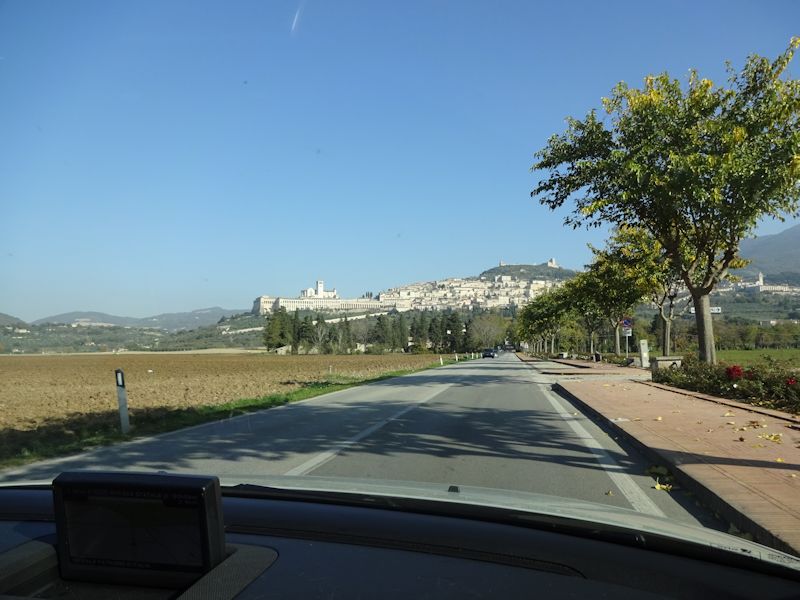
An hour's drive southward over the mountains
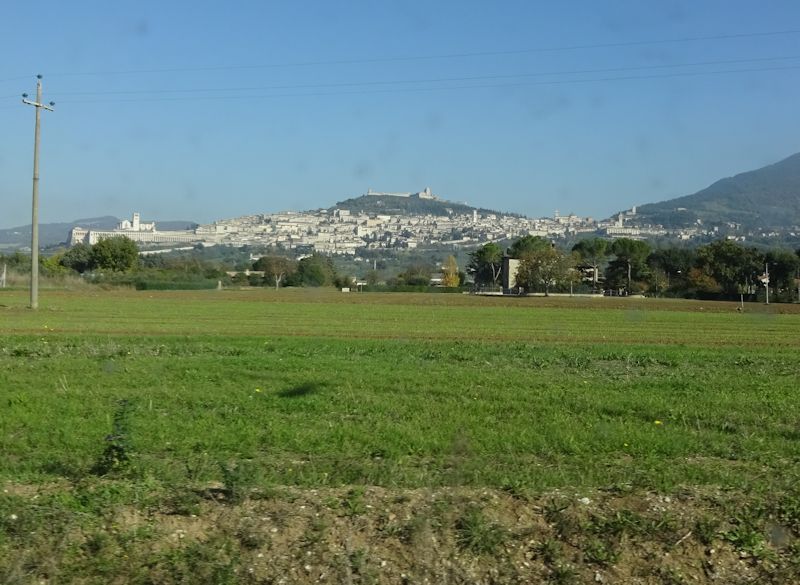
We're approaching Assisi in the Vale of Spoleto from the southwest, with the Rocca or fortress on top and the huge Basilica di San Francesco hanging off the left end of it. Assisi was originally a fortified hilltop settlement of the Umbrians, one of the Italic peoples who arrived in the Italian peninsula somewhere around 1,000 BC, but it came under Roman control with the end of the Samnite Wars in the 290s BC. It flourished as a Roman town extending along the side of Monte Subasio, and remains of Roman city walls, the forum, an amphitheatre and a theatre, and a temple of Minerva can still be seen.
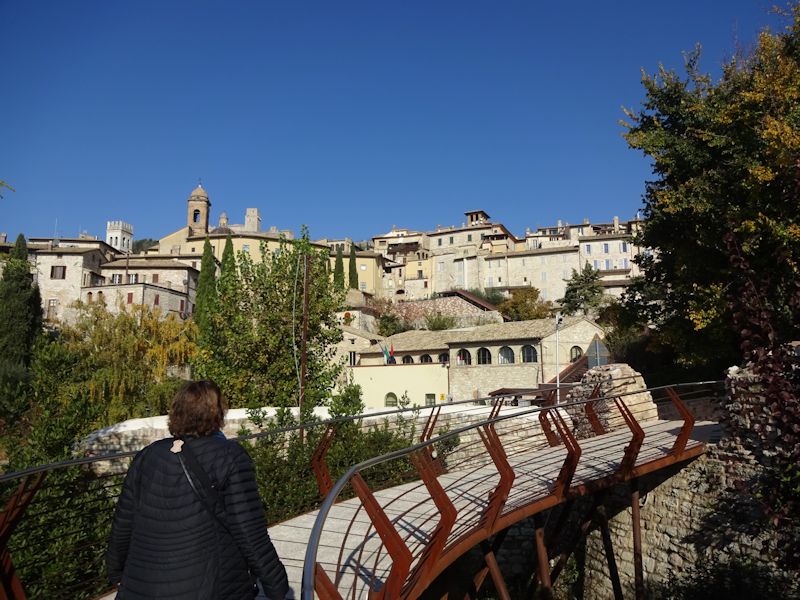
Brand new parking facilities make visiting the city much easier for the million or more tourists and pilgrims who show up every year. Present-day Assisi, with fewer than 30,000 citizens, became a UNESCO World Heritage site -- "Assisi, the Basilica of San Francesco and Other Franciscan Sites" -- in 2000, with a variety of cultural and spiritual justifications for the designation.
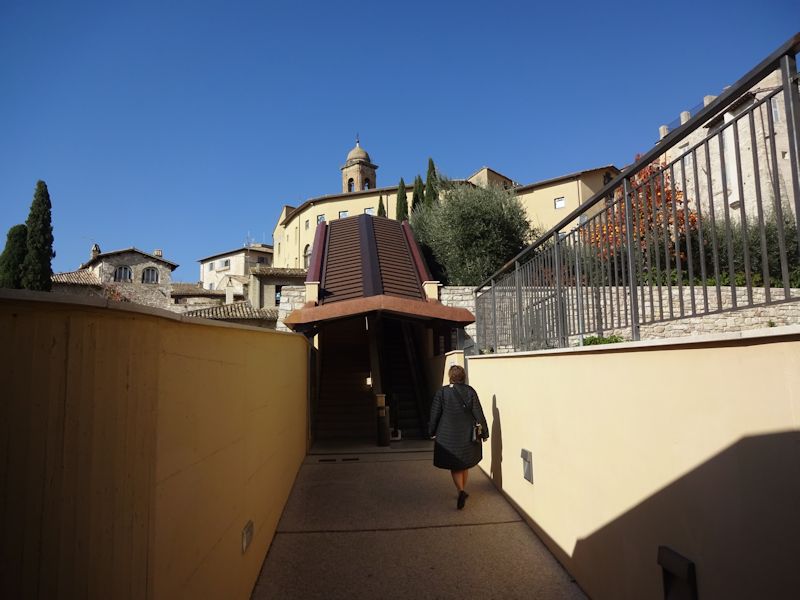
No question, these escalators up to the good stuff are an excellent idea.
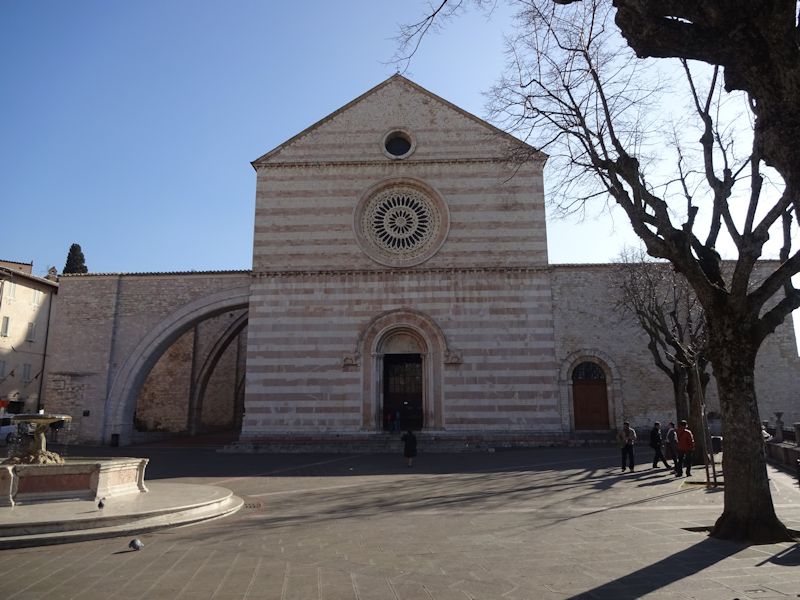
The first sight coming up from the escalators is the Basilica di Santa Chiara, completed in the 1260s to house the remains of St Francis' follower St Clare, founder of the female order of the Poor Clares, which are still there, along with those of her kid sister St Agnes of Assisi. The church is closed for lunch so we'll come back later.
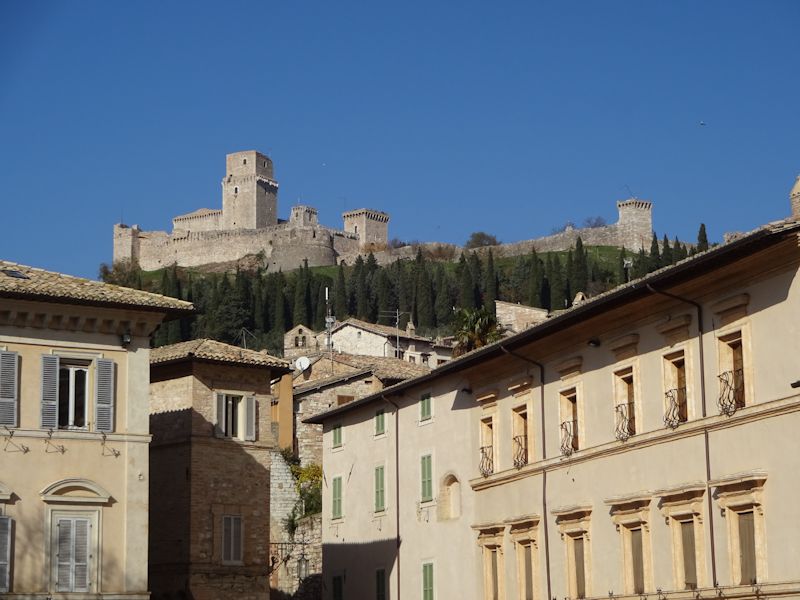
The Rocca on the hilltop. Assisi is said to have been Christianized in AD 238 by the Bishop and martyr Rufino, now the patron saint of the city and presently residing in the cathedral up the hill (we're told). Totila, the brilliant but brutal King of the Ostrogoths during the Gothic War, on his way to capture Rome from the Byzantine commander Belisarius, paused to destroy Assisi as well in 545. Shortly afterward, the Lombards incorporated Assisi into their Duchy of Spoleto, but by the 11th century the city had become an independent commune of the Ghibelline persuasion.
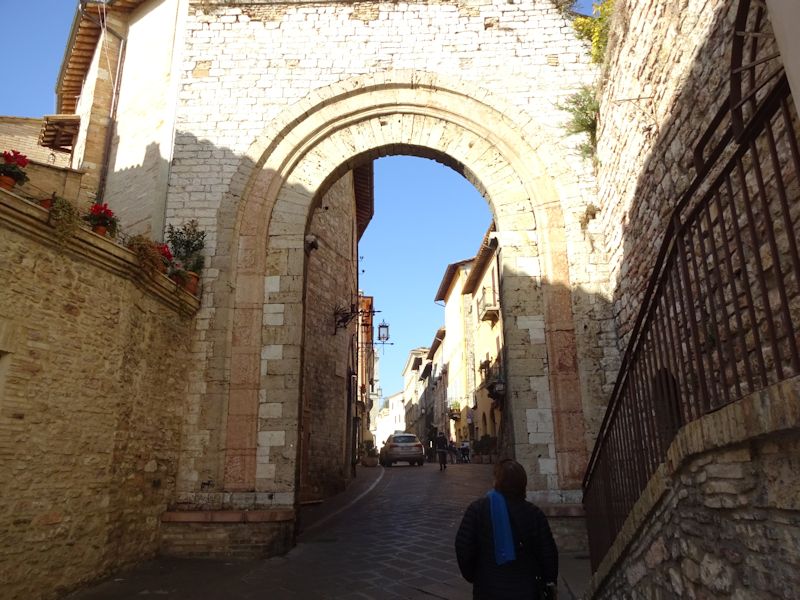
We're pushing up the Via Santa Chiara towards the earlier parts of the old town, the Piazza del Comune on the site of the old Roman Forum. As a self-governing commune, Assisi fought persistently with its neighbors, and especially with the Guelphs of nearby Perugia, in one of the battles of which a local boy named Francesco di Bernardone was taken prisoner and decided to found his own religious order.
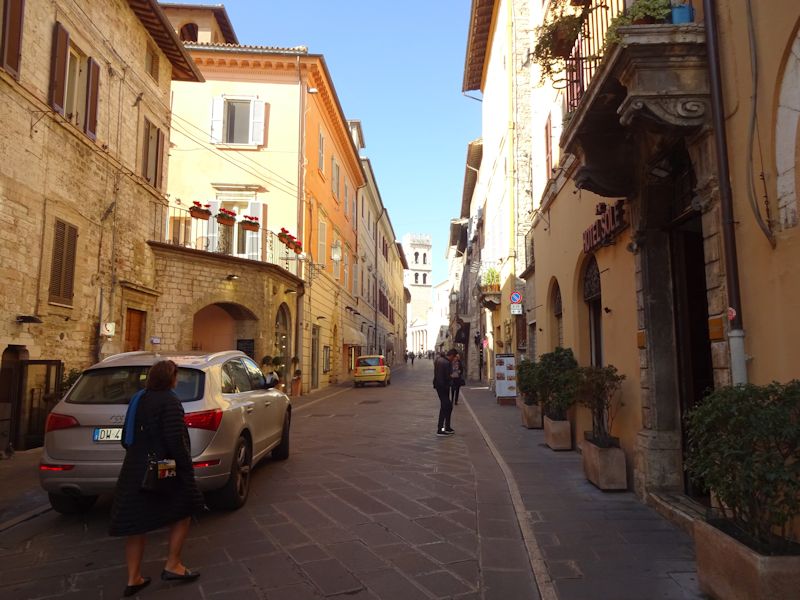
The High and Late Middle Ages were frequently tumultuous times for the Assisianis, ruled at various times by Perugia and by various condottieri like Michelotti, Visconti of Milan and later the Sforzas, and our Gubbian friend the Duke of Urbino, Federico da Montefeltro. In 1367 the grim papal gunman the Spanish Cardinal Albornoz added Assisi to his conquests on behalf of the Papal States and built the fortress shown above to make sure that the citizens understood their new role in the papal order of things.
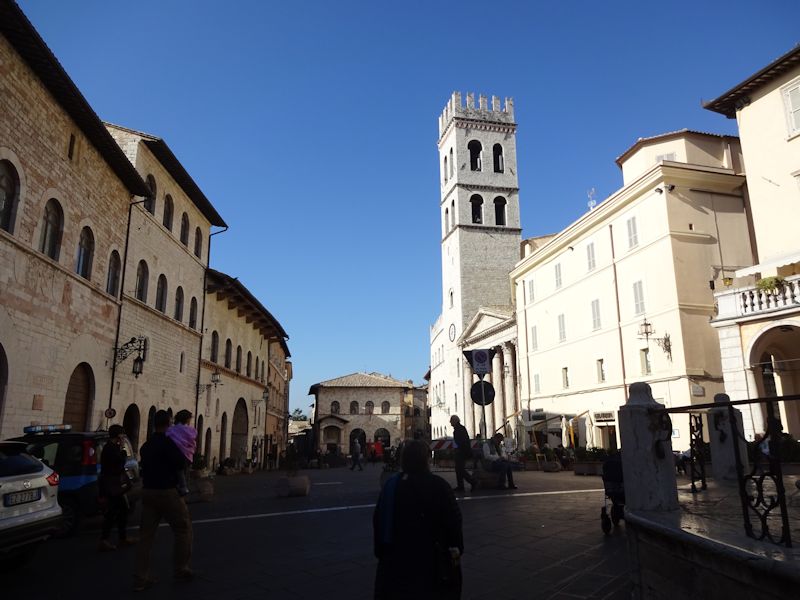
The town centre, the Piazza del Comune, on the site of the Roman Forum, dominated by the Torre del Popolo, Tower of the People, built in 1305, and the Palazzo dei Priori on the left
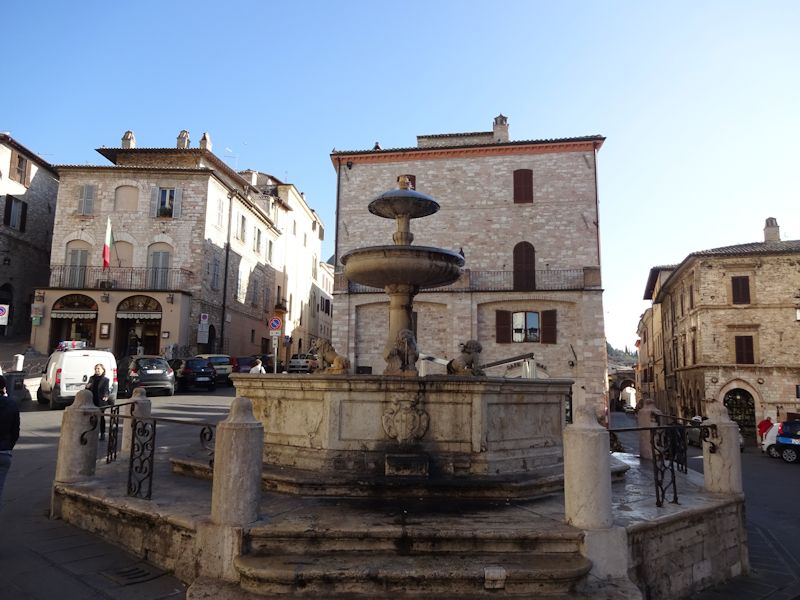
A 16th century fountain with three lions on it, in the Piazza del Comune. Following continued difficulties through the 14th and early 15th century, including Perugia and the Black Plague, Assisi came finally under papal control in the second half of the 15th century and like most cities within the Papal States began its long decline, offset towards modern times by the growing pilgrim and tourist fascination with the stories of St Francis. Assisi is presently the third most visited pilgrimage destination in Italy (after St Peter's and Padre Pio's shrine).
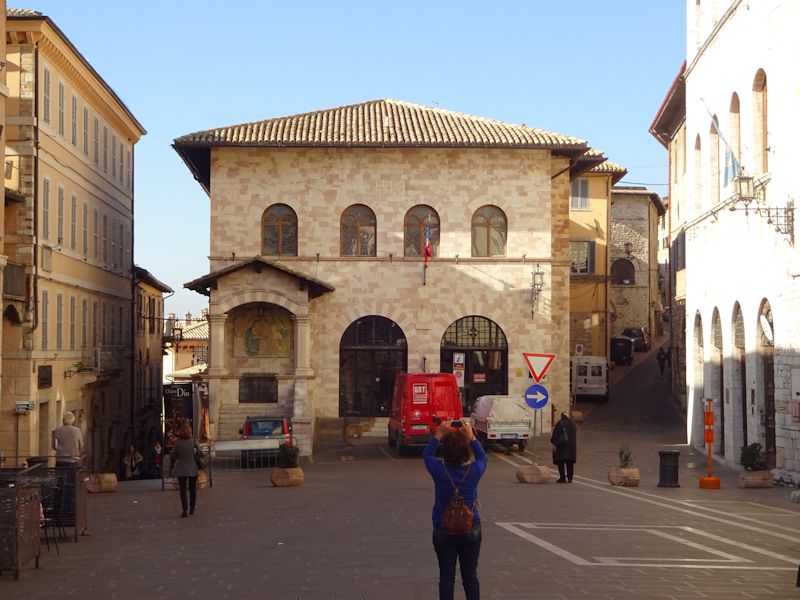
The tourist office at the far end of the Piazza del Comune, at the head of road leading out to the St Francis Basilica (left)
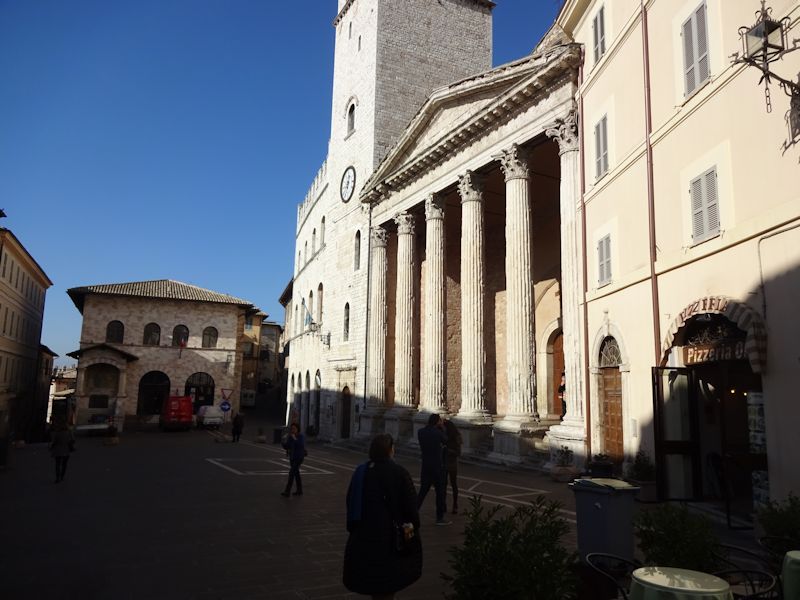
Just beyond the Torre del Popolo, the Palazzo del Capitano del Popolo dates from the mid-1200s (though the pseudo-fortification merlons across the top are modern additions). The thing that looks like a Roman temple, with six Corinthian columns out front, is a Roman temple, the Temple of Minerva, the goddess of wisdom, from the 1st century BC.
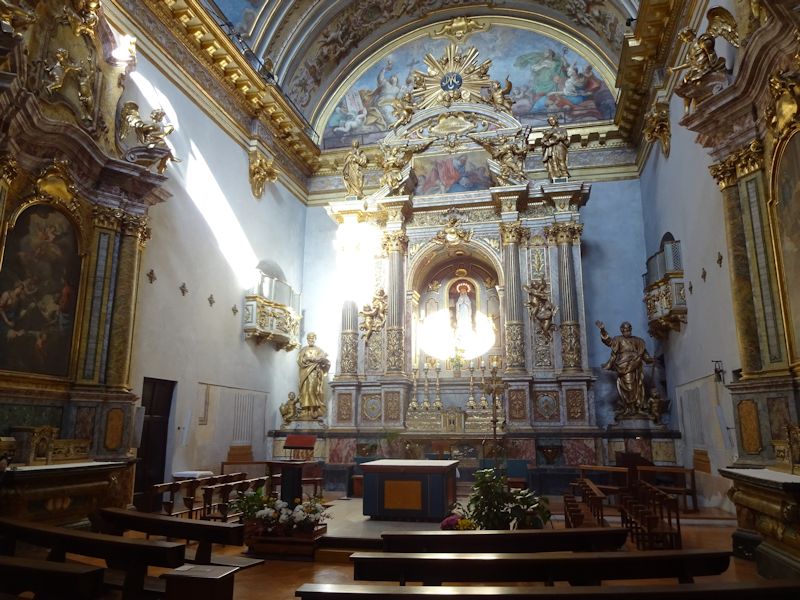
The interior looks distinctly less ancient Roman than the exterior, unfortunately -- all of this was built in the 16th century and extensively renovated in the 17th.
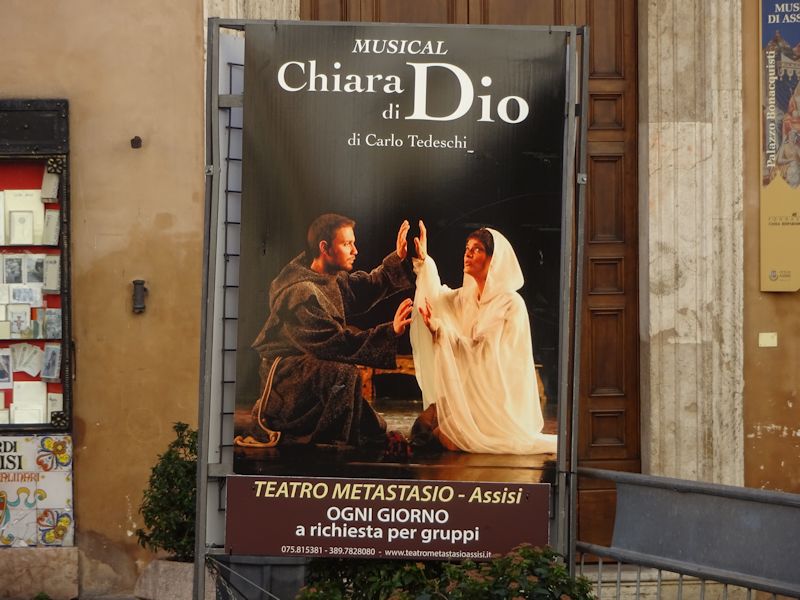
A musical about St Clare. Probably very inspiring. Especially for groups.
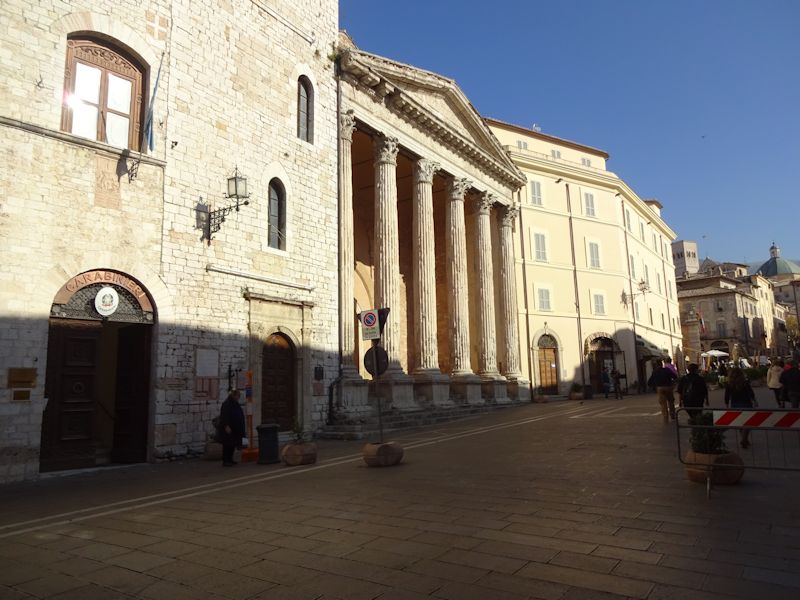
The Palace of the Captain of the People (now the Carabinieri post), the Tower, and the Temple of Minerva, appropriately called the church of Santa Maria sopra Minerva.
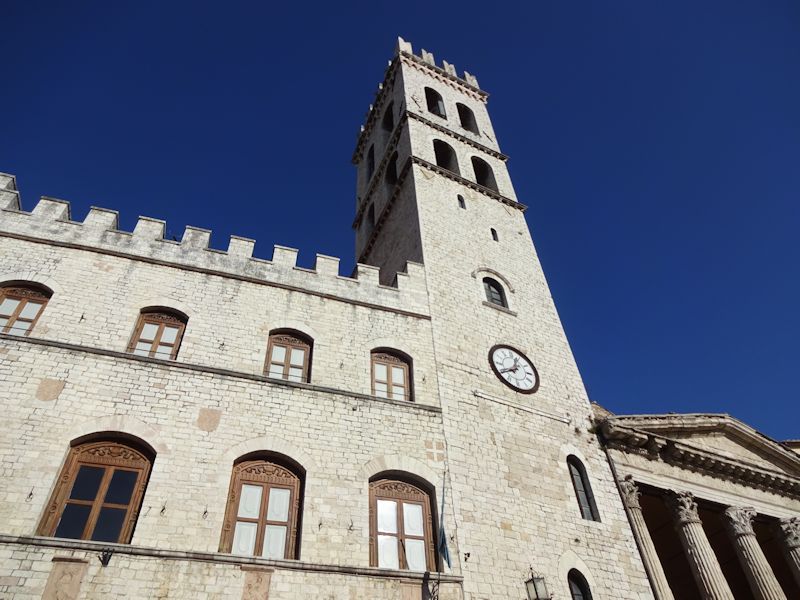
The Torre del Popolo
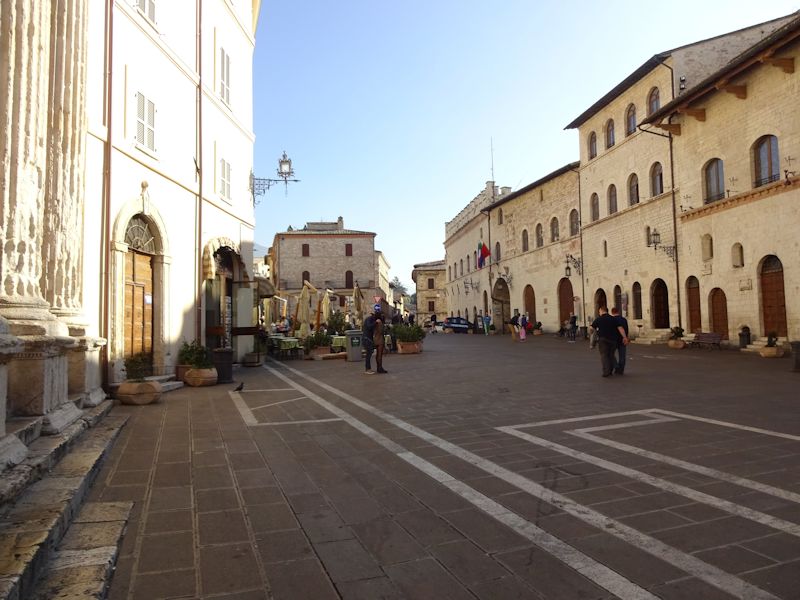
The Palazzo dei Priori and city hall (from 1275 but much restored) on the far side of the piazza; it bears the sign for the city art gallery, which is no longer there, and in the end we didn't find it.
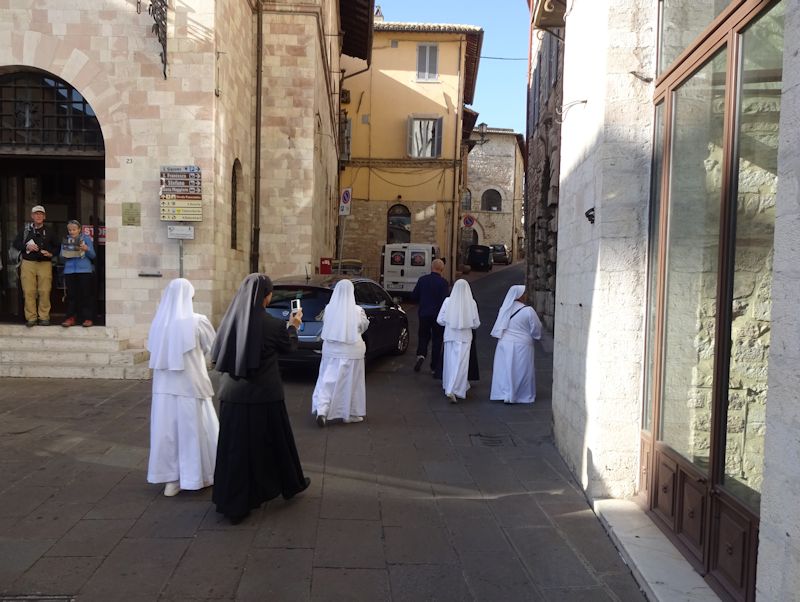
Assisi's tourists come from all over, but a surprising number of the pilgrims seem to be nuns from Indonesia.
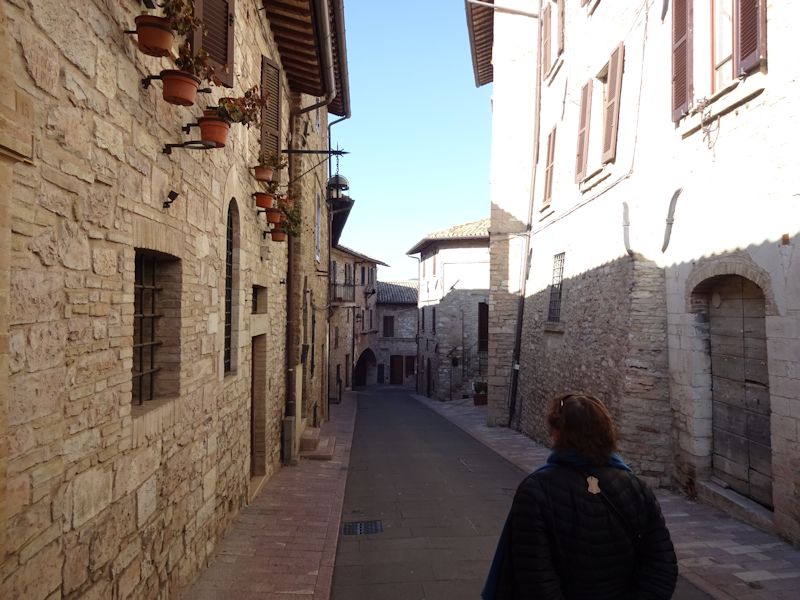
The Via San Paolo (one street up from the Via San Francesco) towards the basilica
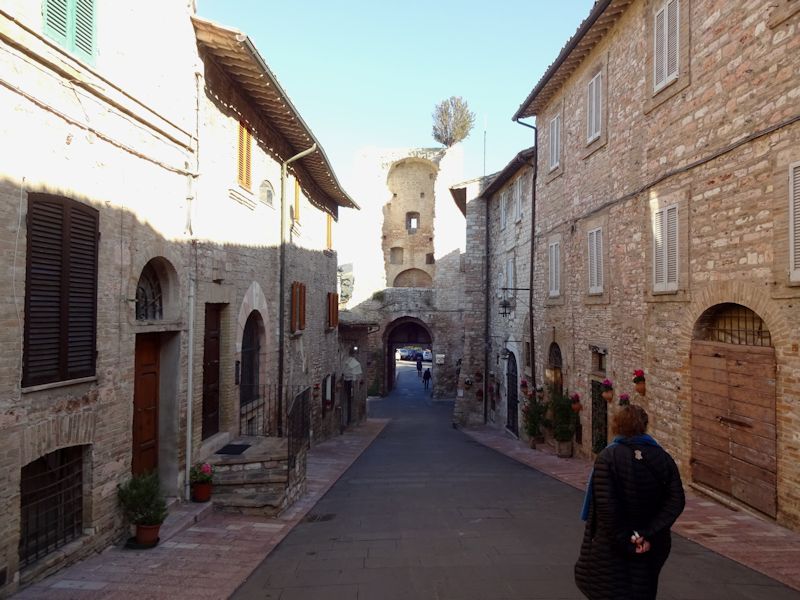
Down the hill towards the city gate of San Giacomo, then a sharp left turn still inside the walls
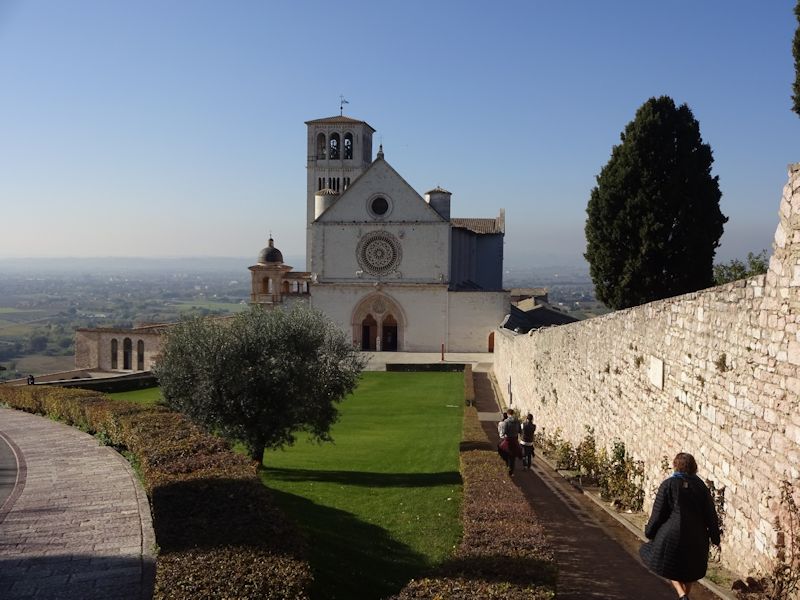
The double Basilica di San Francesco, the 'mother church' of the Order of Friars Minor, or Franciscans, perched out over the Vale of Spoleto
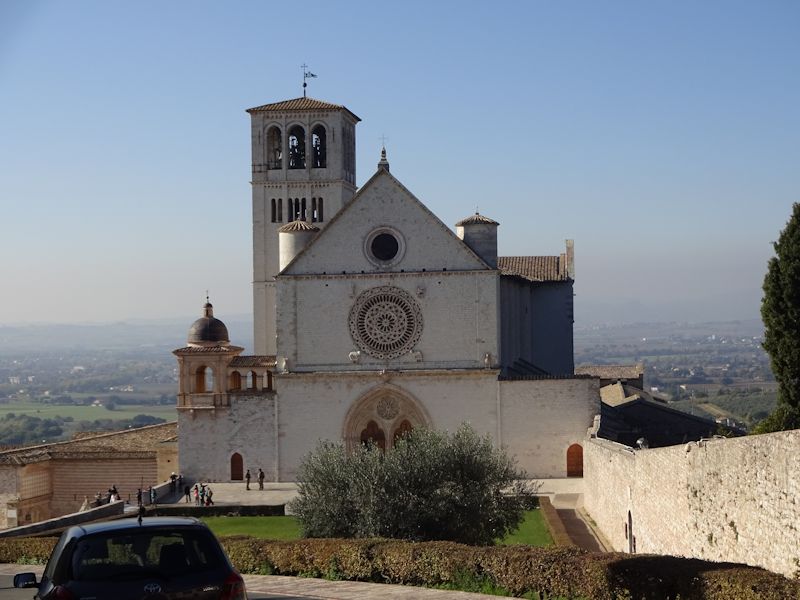
That's the upper church -- the lower church was ceremonially begun in 1228 by Pope Gregory IX, just after he'd canonized the saint; the work was overseen by Brother Elias himself, St Francis' right-hand man and his successor as leader of the order for a time. The lower church was completed in 1230 and Francis' remains were installed here (though hidden by Brother Elias and not discovered until 1818); the upper church was begun around 1239 and both were consecrated in 1253. The earthquake of 1997 caused considerable damage, and killed four people inside, but the restorations were completed and the church reopened within two years.
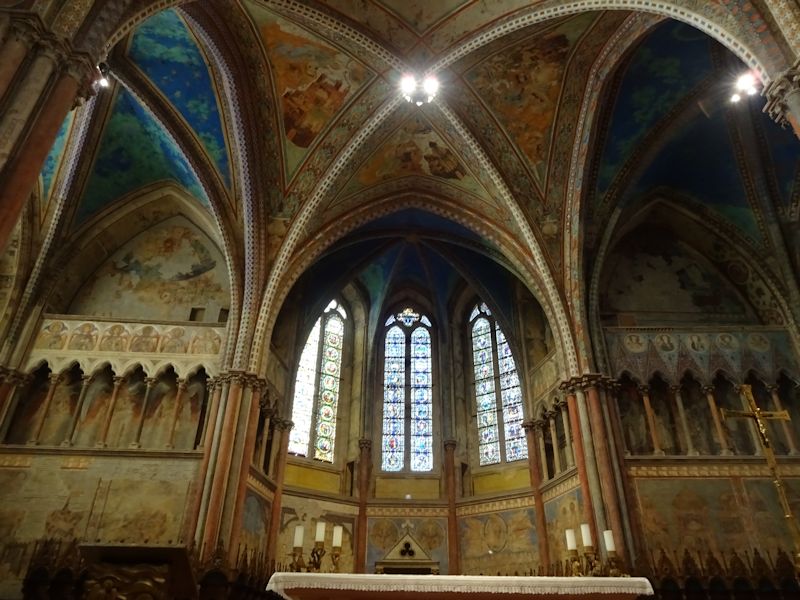
The choir and ceiling near the crossing in the upper church. The Basilica of St Francis is a no-nonsense No Photo! establishment, heavily patrolled (photos can really eat into those postcard revenues), so these few no-flash pictures are basically targets of opportunity.
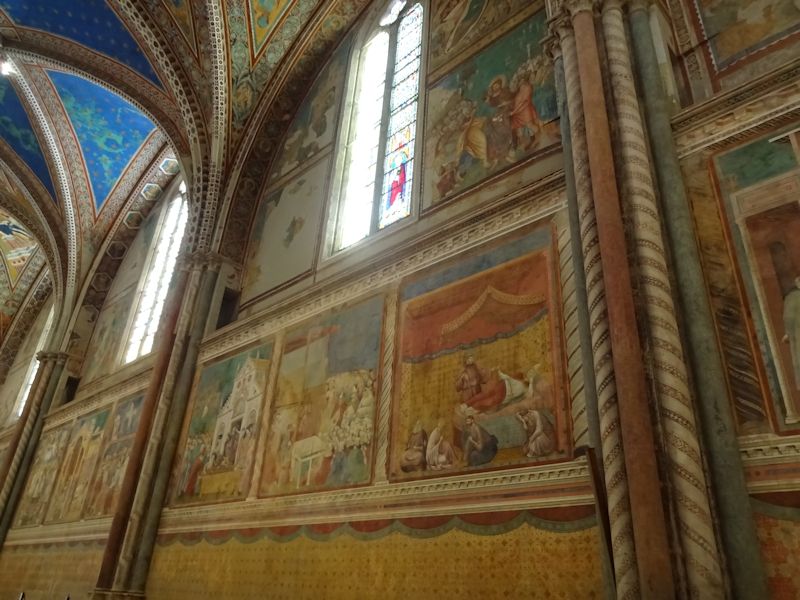
Half a million fresco scenes from the busy life of St Francis. Attributions are fraught with bitter controversy, but Cimabue's contributions seem to be more or less agreed, whilst there's a consensus that Giotto is all over the place in the upper church, but not on which ones.
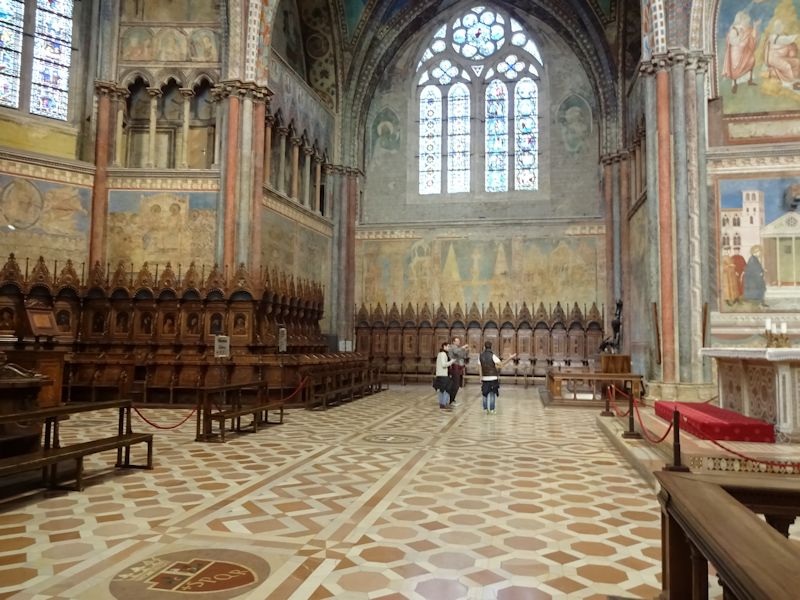
The right transept and the crossing, behind the altar
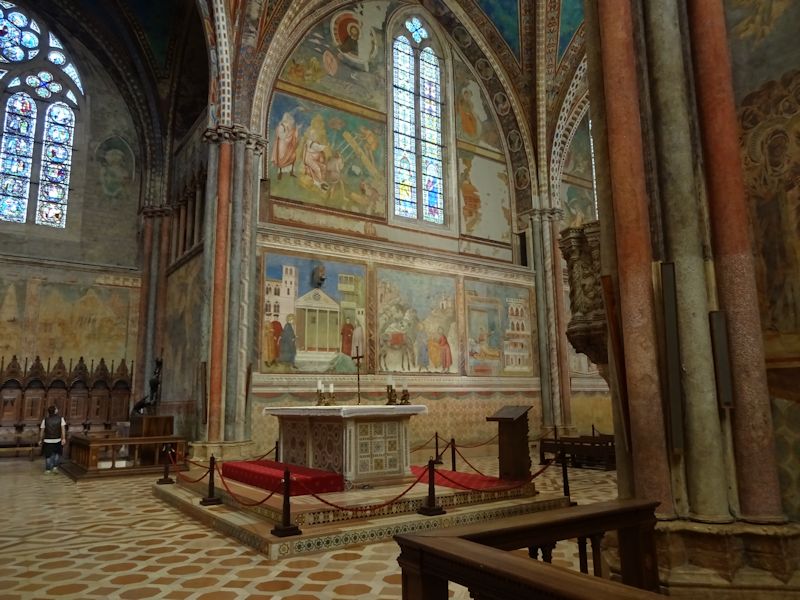
The altar and more St Francis frescoes along both sides of the nave
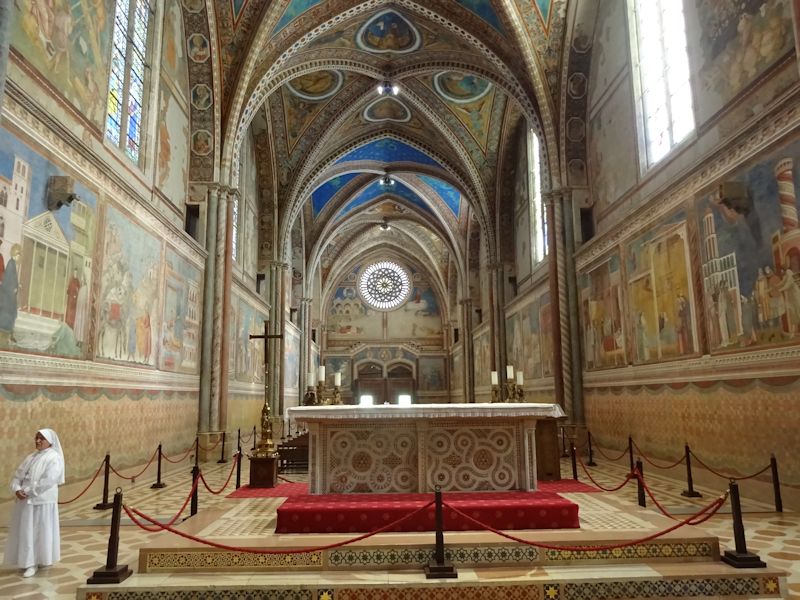
The simple Gothic nave with no aisles, from behind the altar
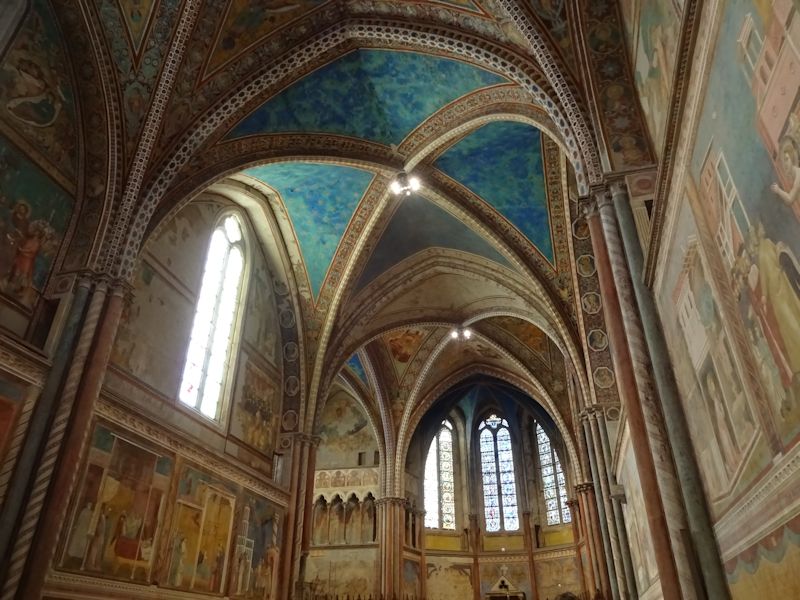
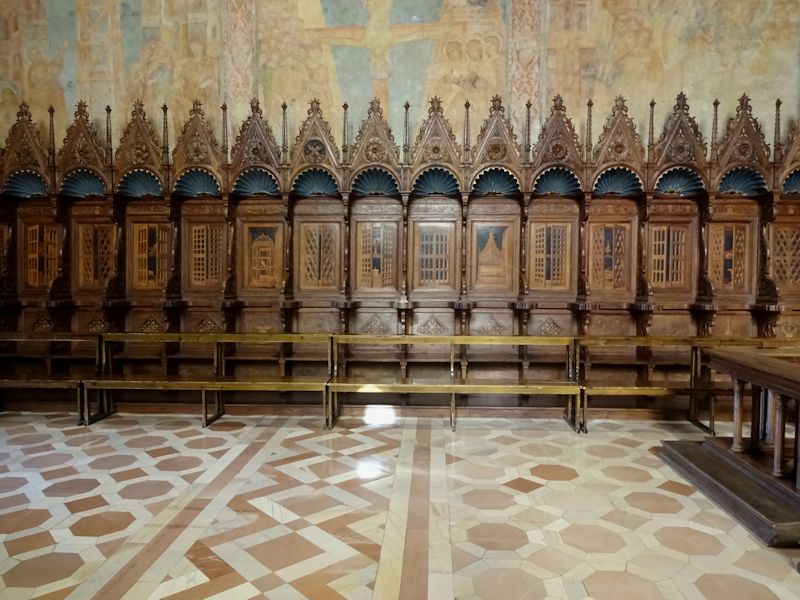
The choir along the transept walls with more than 100 15th century wooden intarsia stalls
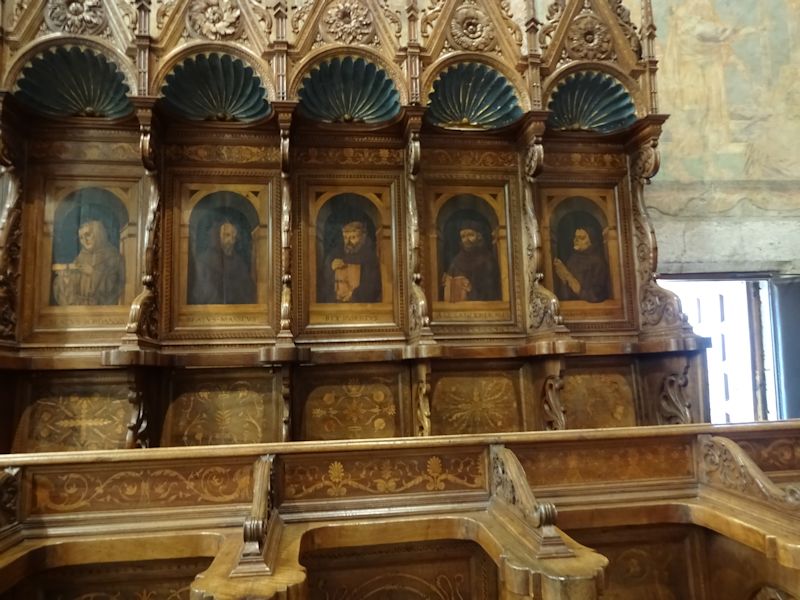
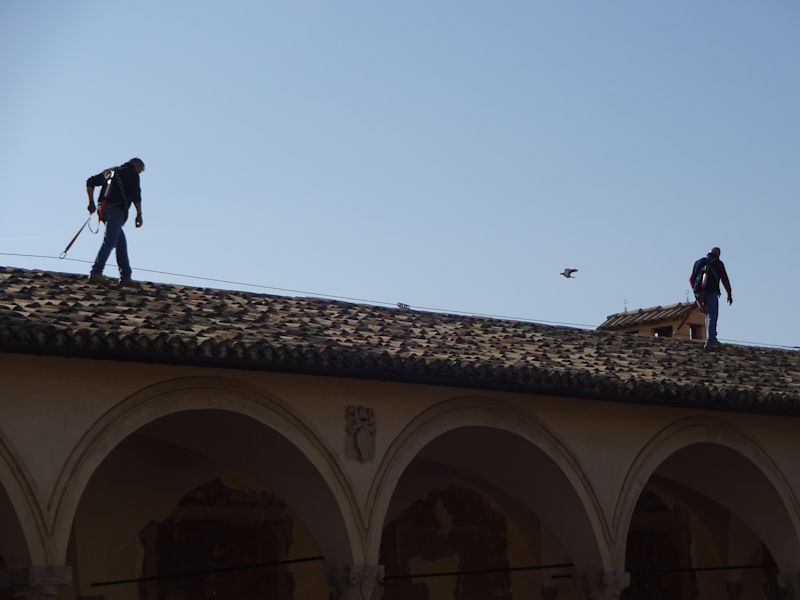
Roof walkers
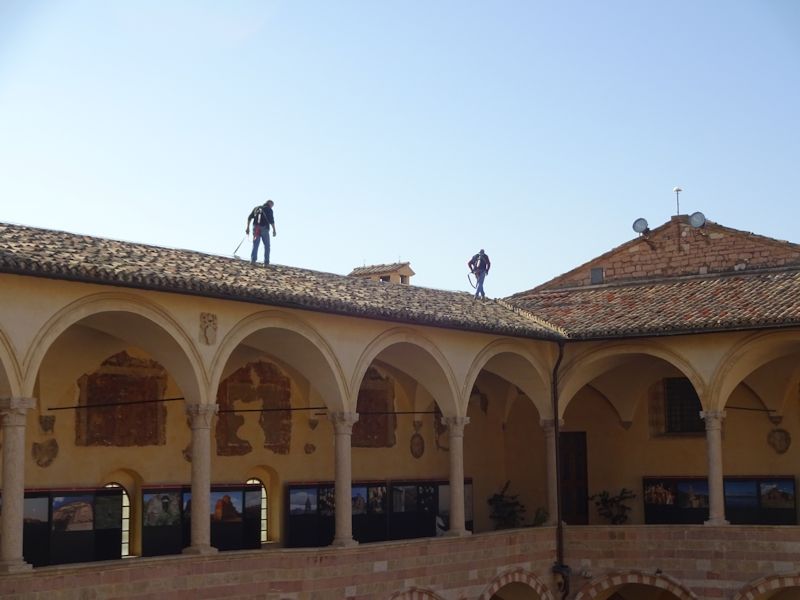
Roof walkers over the cloister
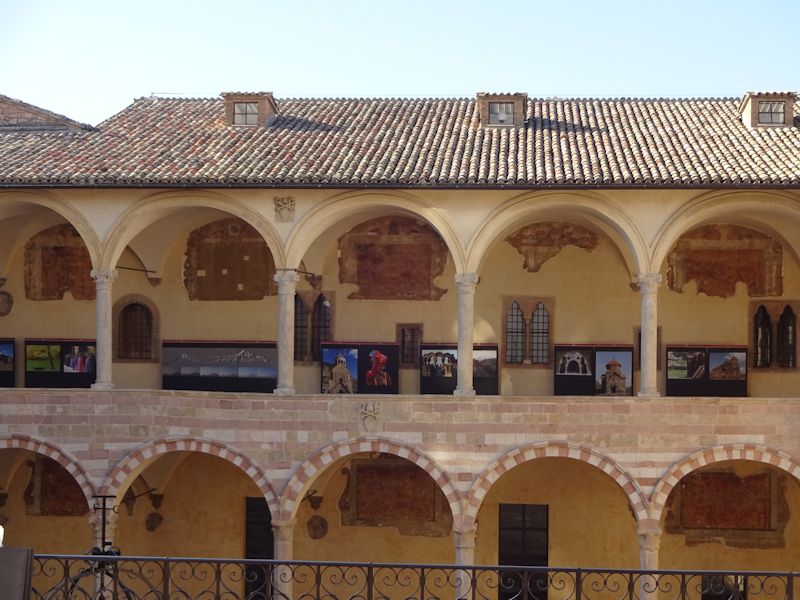
The attached Franciscan friary called Sacro Convento, coeval with the lower church and housing dormitories, etc., for the friars, and an estimable library, now a theological centre for training seminarians.
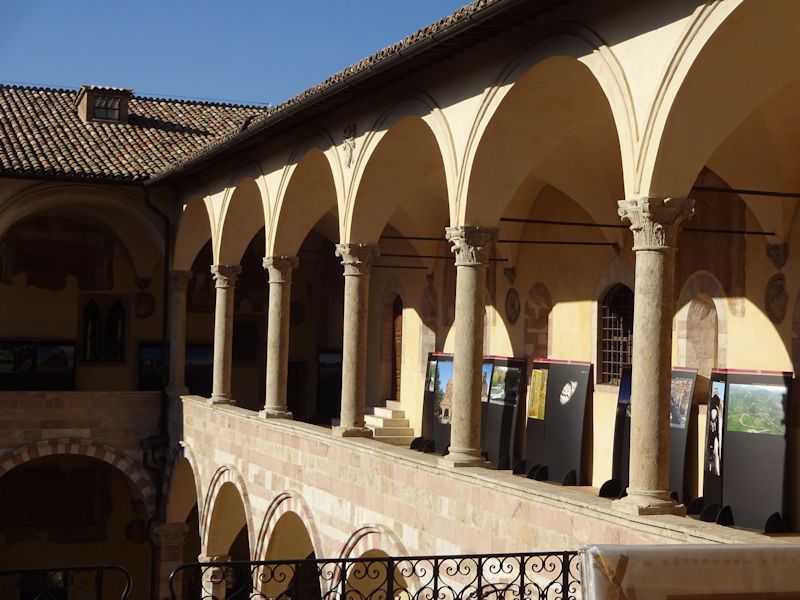
From here there's a back door downstairs into the lower church
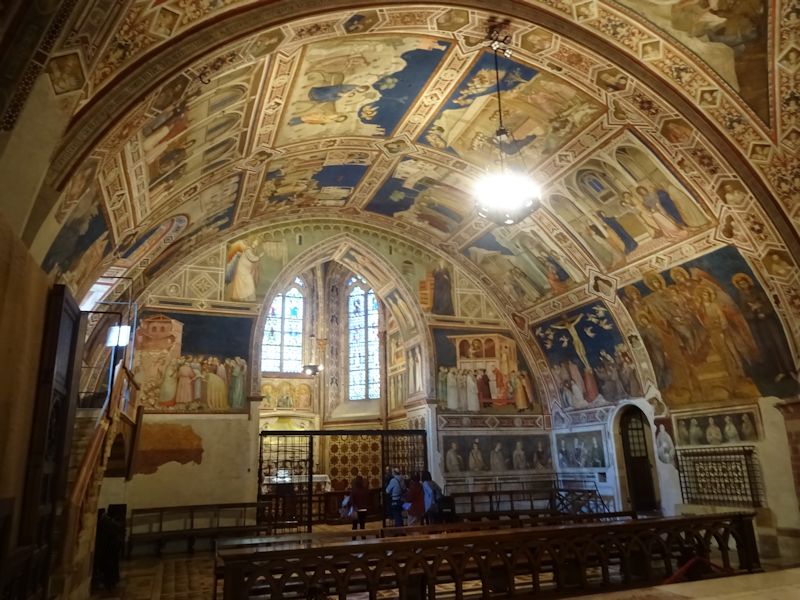
The lower church is as cramped as the upper one soars
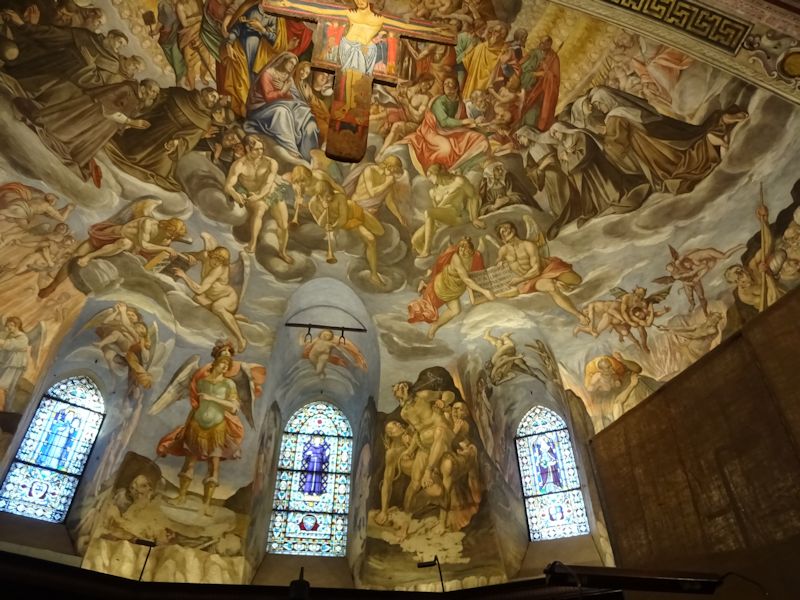
End Times
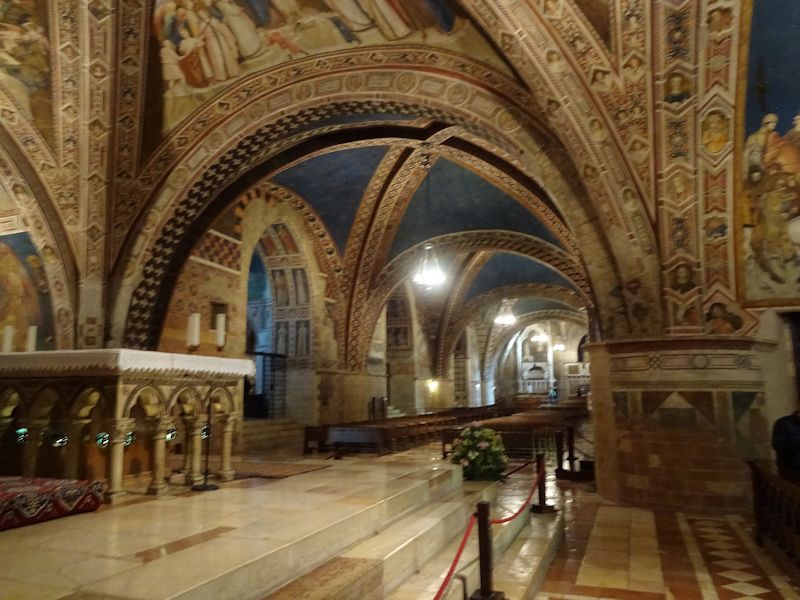
Beneath the lower church, seen here, there is a modern crypt, built in the 19th century and redesigned with a Romanesque look in the 1920s, to hold the remains of St Francis after they'd been found in 1818 under the floorboards, where Brother Elias had hidden them to keep them safe from medieval relic-hunters, pirates, and popes. The crypt is closely guarded now, and there are no targets of photographic opportunity there.
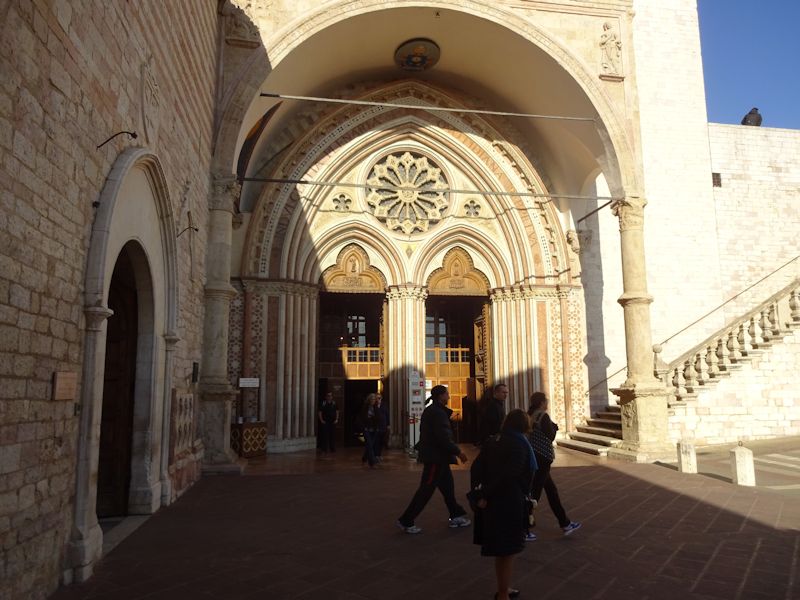
Out the front door of the Basilica inferiore. From what one reads about the crowds jostling shoulders round here in the summer and religious seasons, mid-November is definitely the right time to visit.
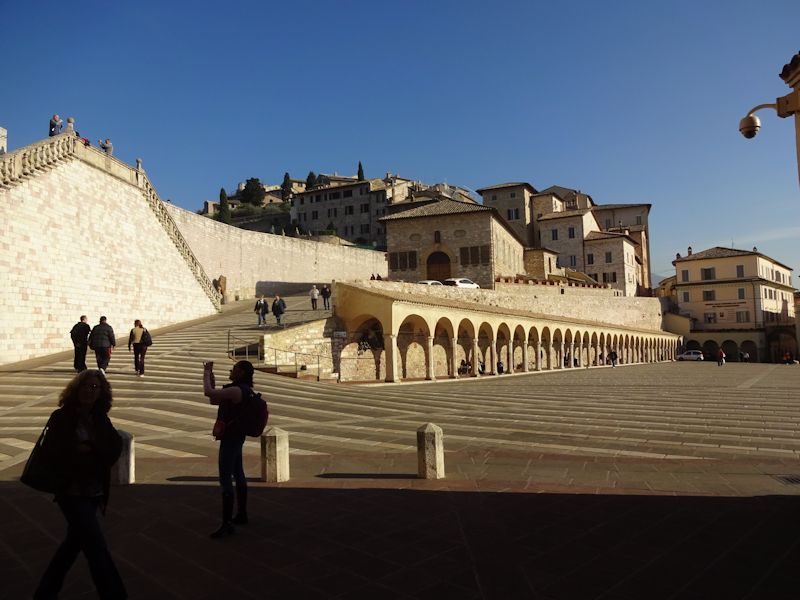
The porticos of the Piazza Inferiore and the ramp up to the Via San Francesco back into town
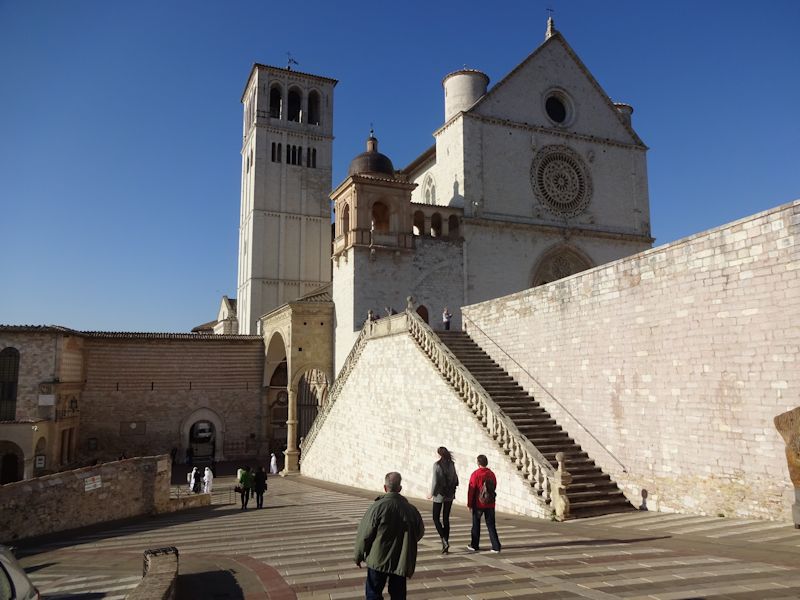
The lower and upper churches
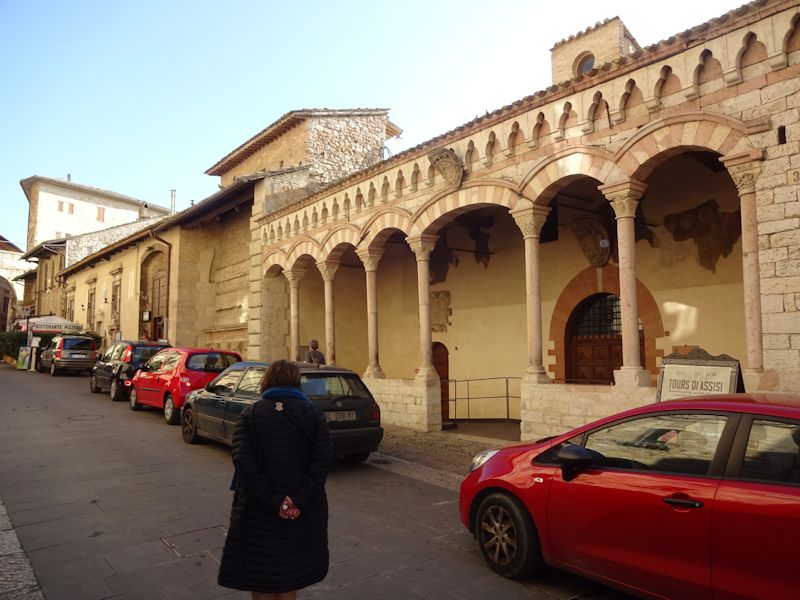
Along the Via San Francesco. Assisi, and the site of the saint's own little hut, the Porzuincola (now enclosed in the mammoth Basilica of Santa Maria degli Angeli just 4km down the hill), became increasingly important pilgrimage destinations from soon after his canonization in the 13th century, but their numbers blossomed after Francis and Catherine of Siena were named co-patron saints of Italy in 1939.
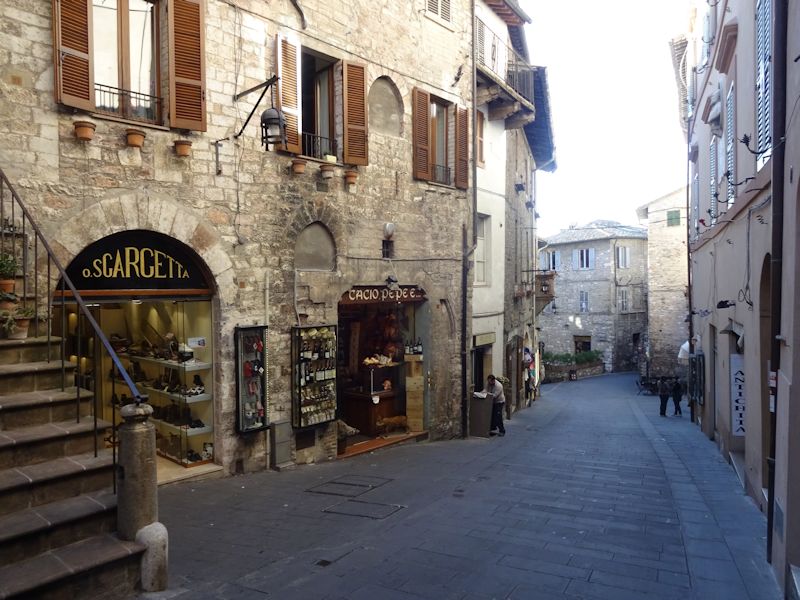
The Via Portica up to the Piazza del Comune
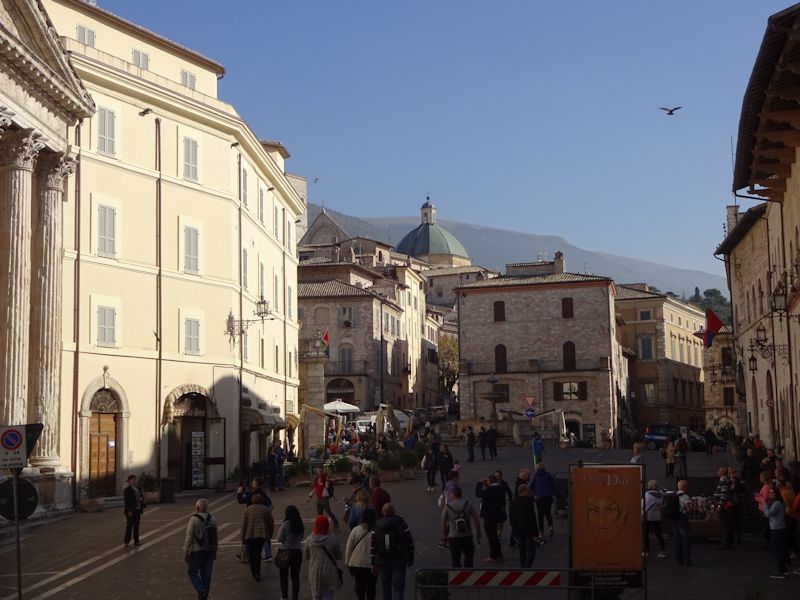
The Cathedral of San Rufino peeking over the Piazza del Comune -- but first, a nice light lunch in a little place just off the road up the hill.
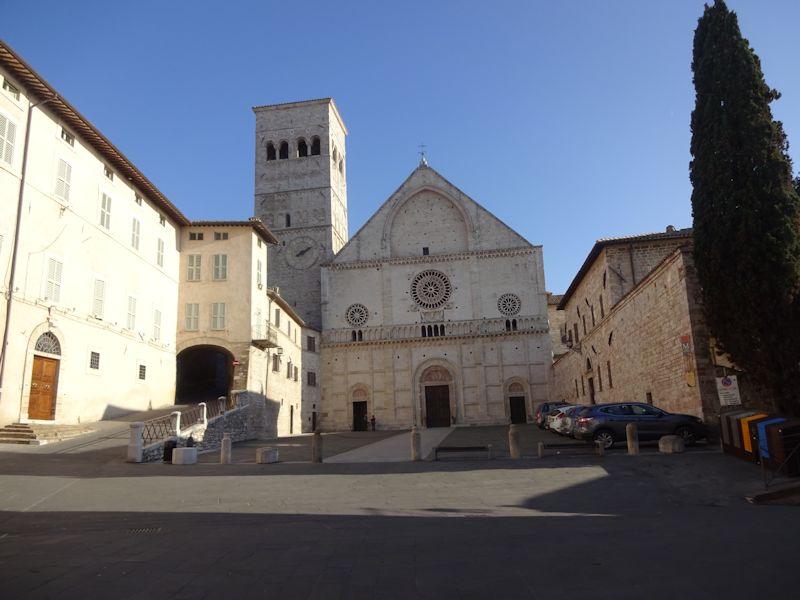
The Cathedral of San Rufino, dedicated to the reputed first Bishop of Assisi in the 3rd century, who was martyred elsewhere but whose remains were translated back here in the 8th century.
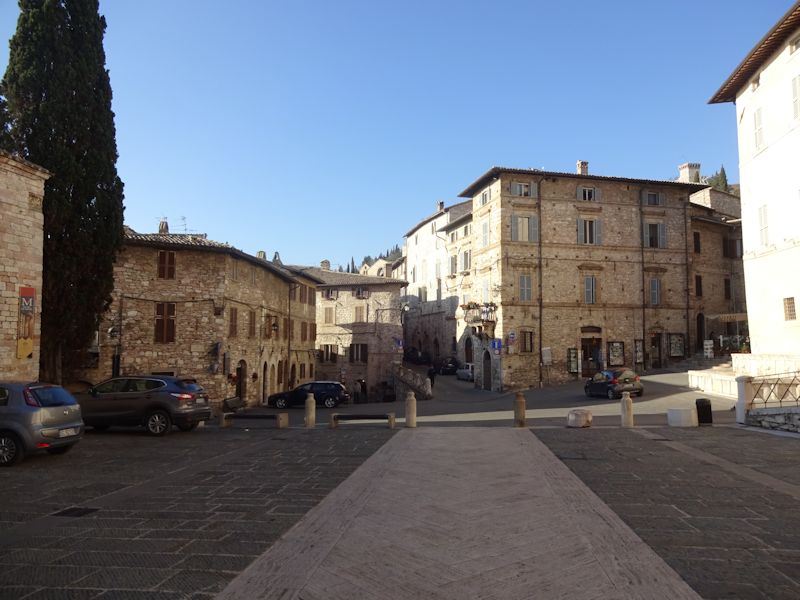
The small Piazza San Rufino out front of the Duomo
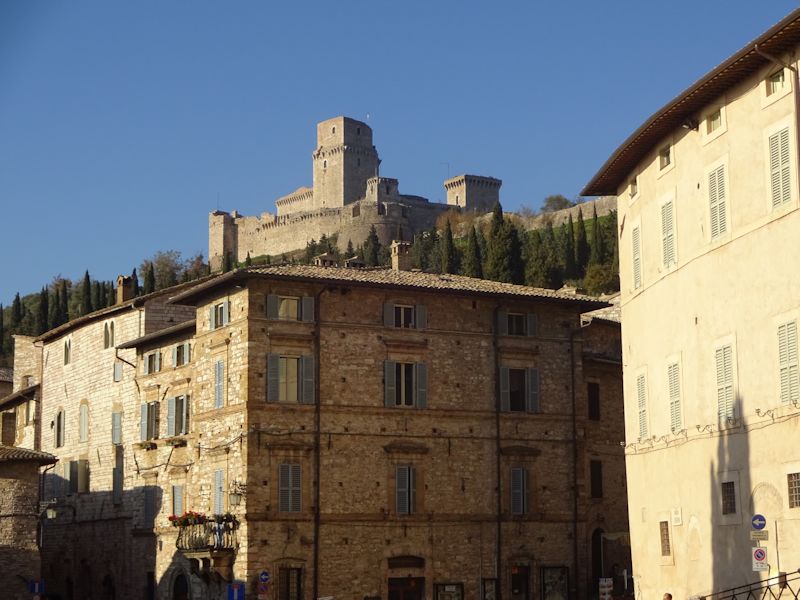
The Albornoz fortress keeping a watchful eye on the Assisianis and their visitors
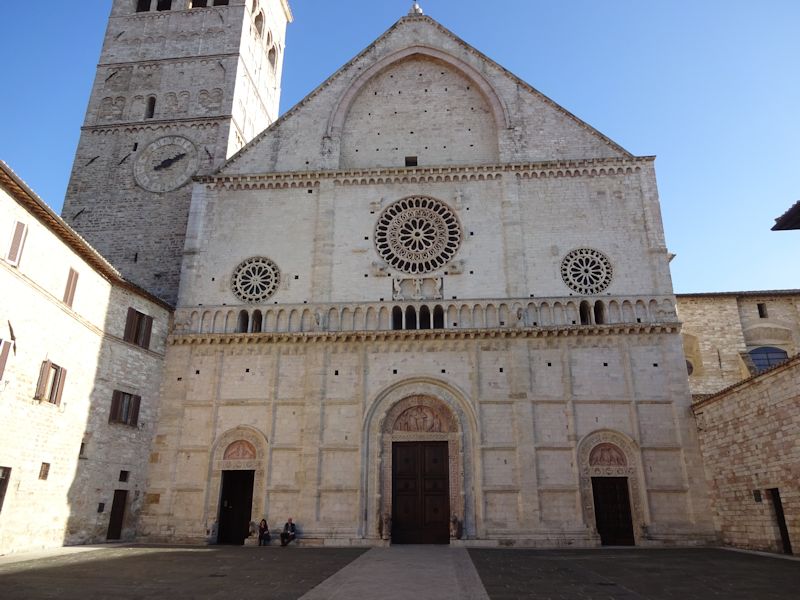
The Romanesque façade of the Cattedrale di San Rufino di Assisi, the third building on this spot for the custody of Rufinus' remains; this one was begun in 1140 and was sufficiently far along that Saints Francis and Clare and many of their followers could be baptized here later in the century. Clare is said to have heard Francis preaching here in 1209 and to have joined up immediately. The high altar was consecrated by Pope Gregory IX when he came for the canonization party for Saint Francis in 1228, and the building was completed in 1253.
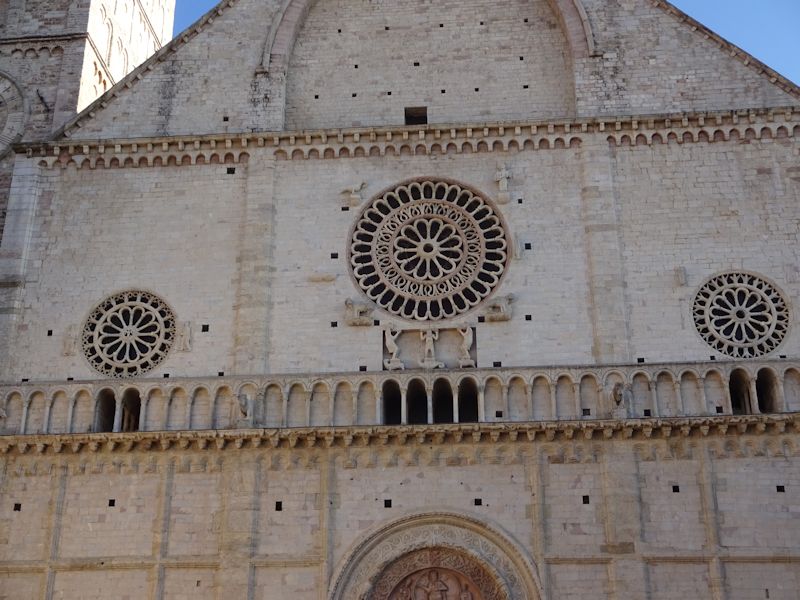
A three-part façade, with three rose windows and three doors; there is an assumption that something decorative but spiritually meaningful was meant to go into the empty central arch at the top. The central rose window seems to be held up by three telamons and surrounded by the iconographic animals representing the Evangelists.
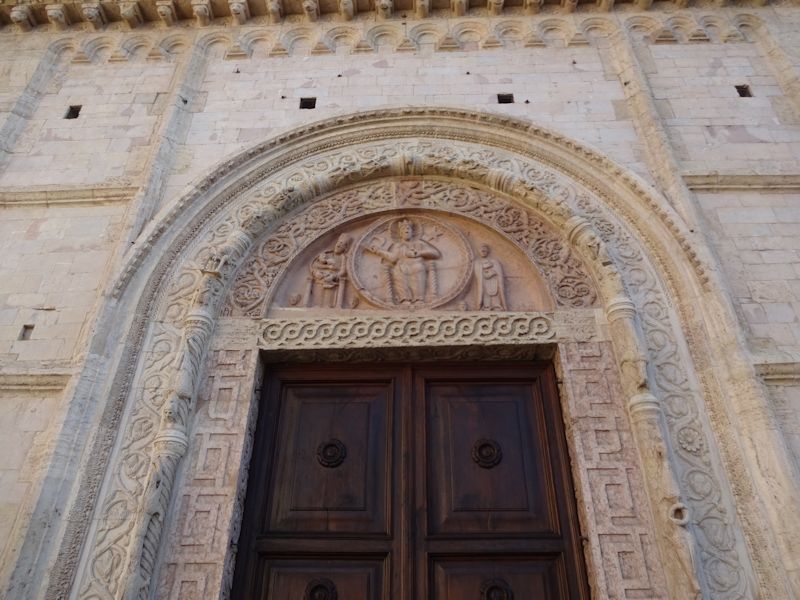
The fabulous central front door, with Christ on a throne in the tympanum, Mary and Child on the left, and St Rufinus on the right
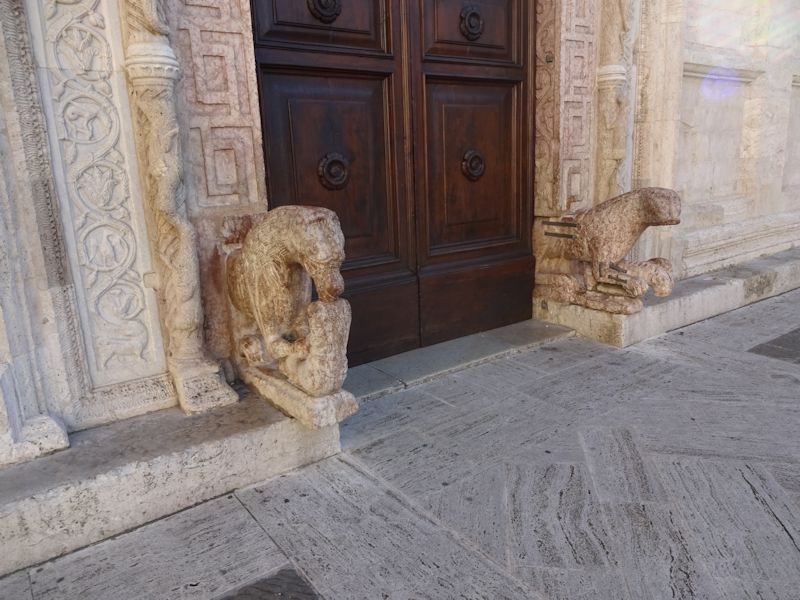
In front of the central door, the well-known iconographic motif of lions eating people!
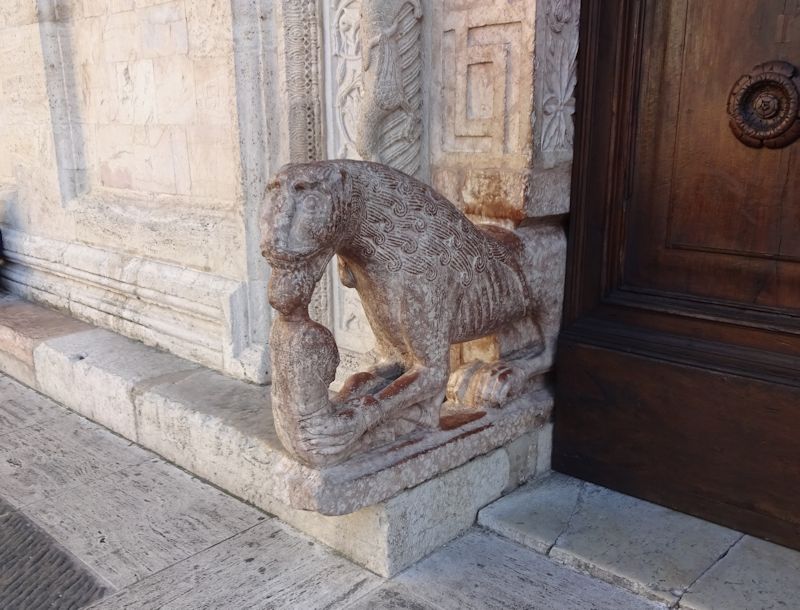
Deeply meaningful, one supposes, at some level
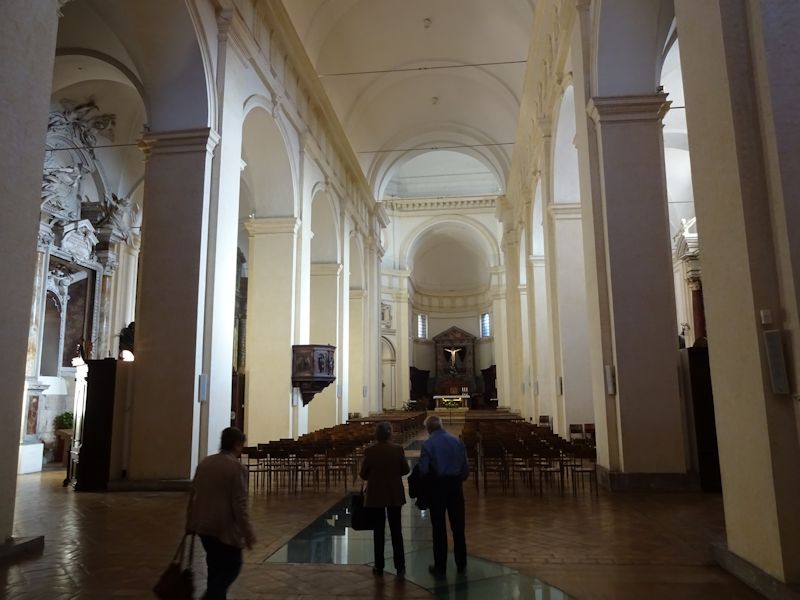
The interior nave with two aisles is no longer Romanesque! It was entirely redone in the later 16th century, and the altar is from the 19th (except for the Roman sarcophagus under it, with Rufinus inside (they say)). Off to the right is the font at which Francis (1182), Clare (1193), and possibly the future Emperor Frederick II Hohenstaufen (1194) were baptized.
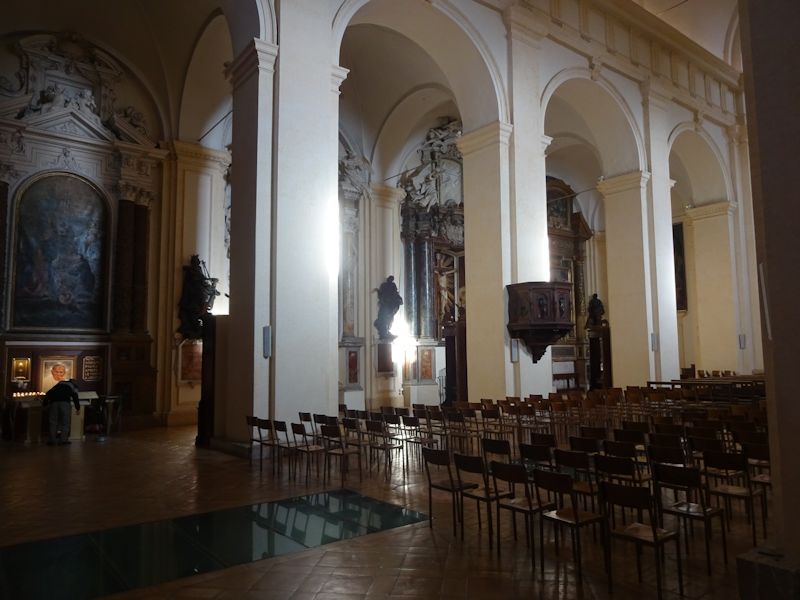
Most of the frescoes date from the later 17th century and need not detain us for too long.
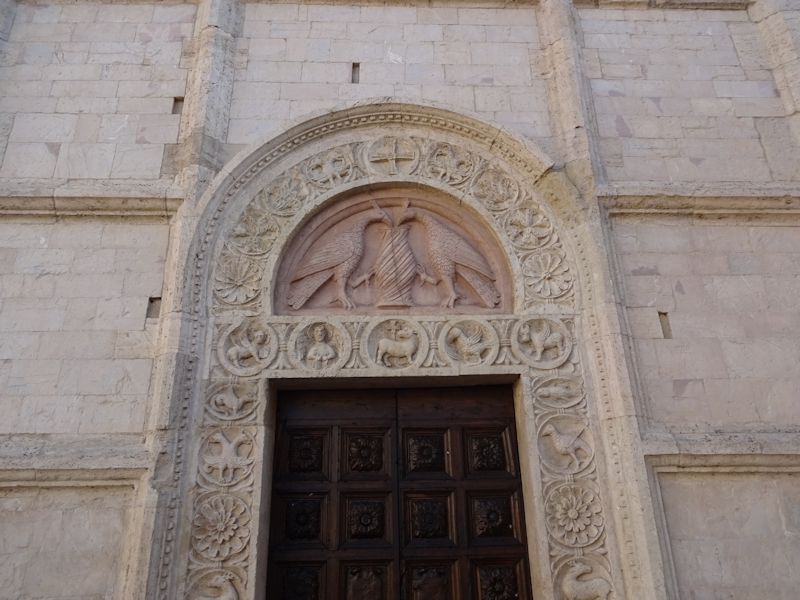
Griffins in the lunettes on the side doors, and saints, symbolic evangelists, flowers, and weird animals are everywhere.
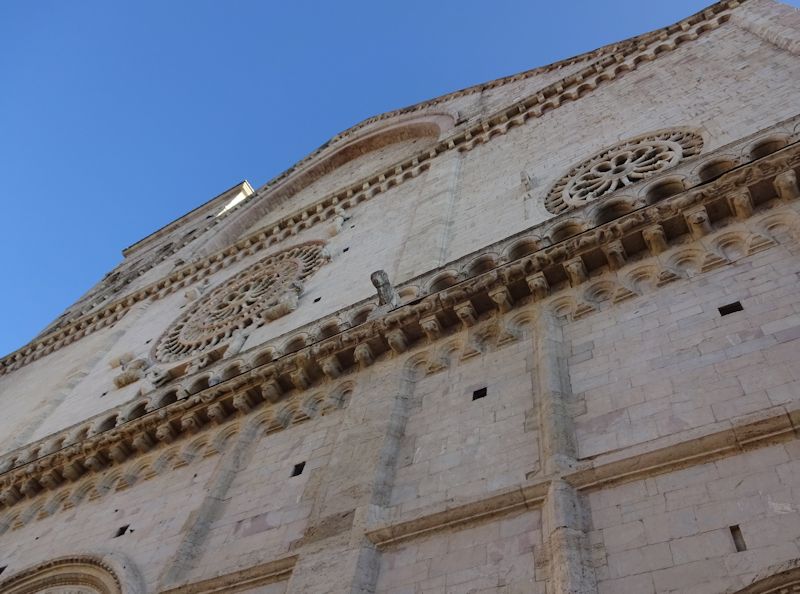
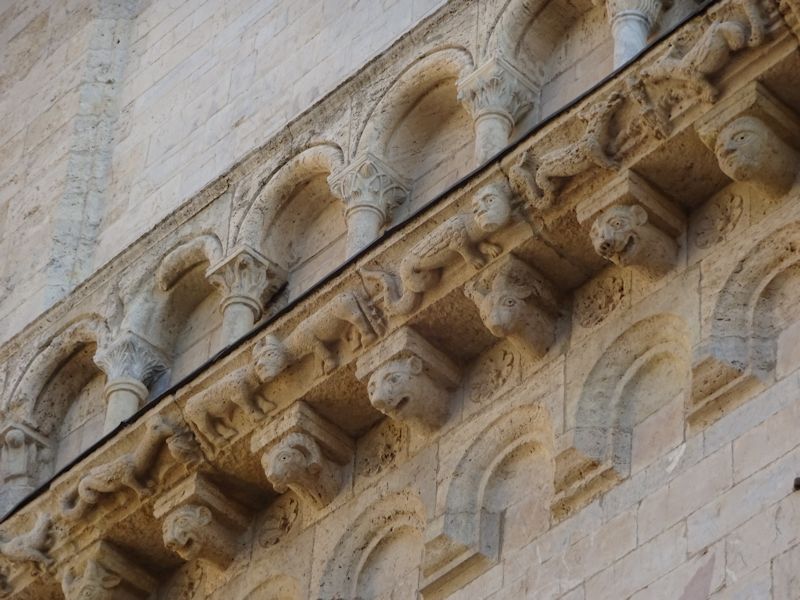
Details of the façade
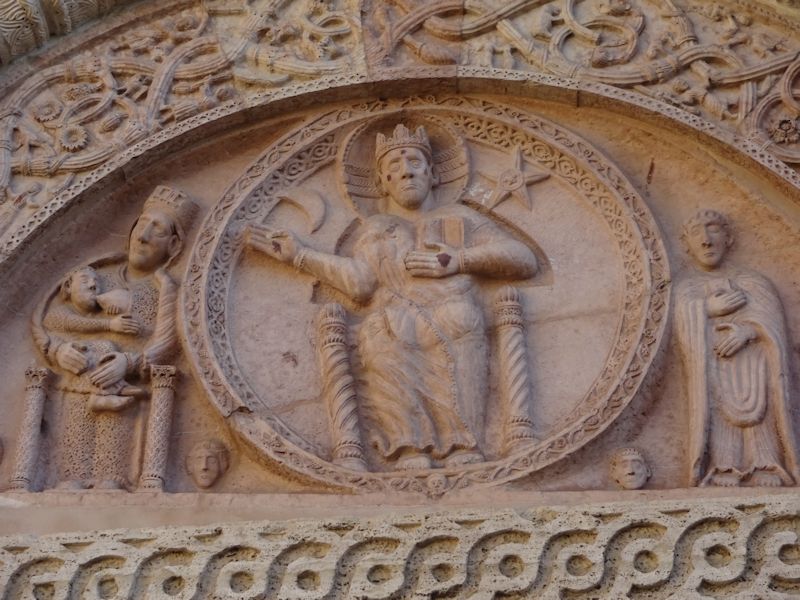
The tympanum over the centre door, with a pop-eyed Christ Enthroned and a Virgin Mary nursing Baby Jesus in an anatomically incorrect manner
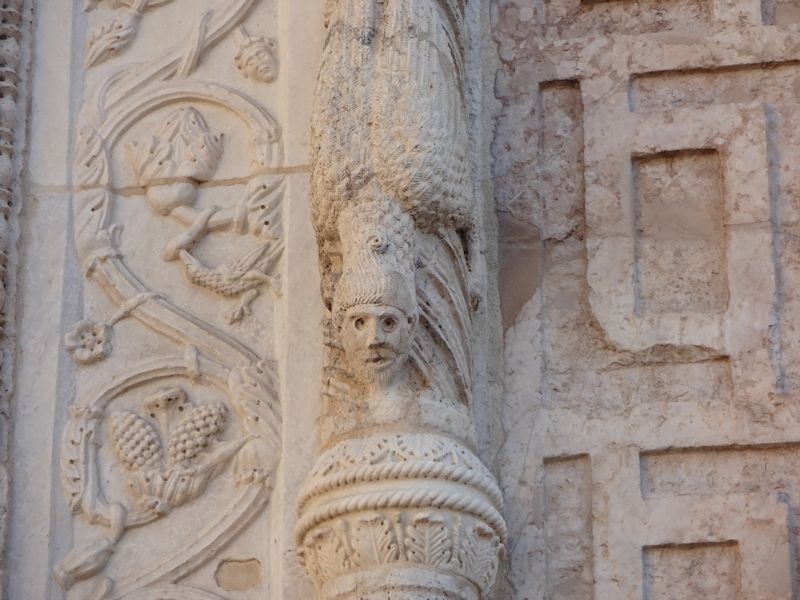
-- Now go away.
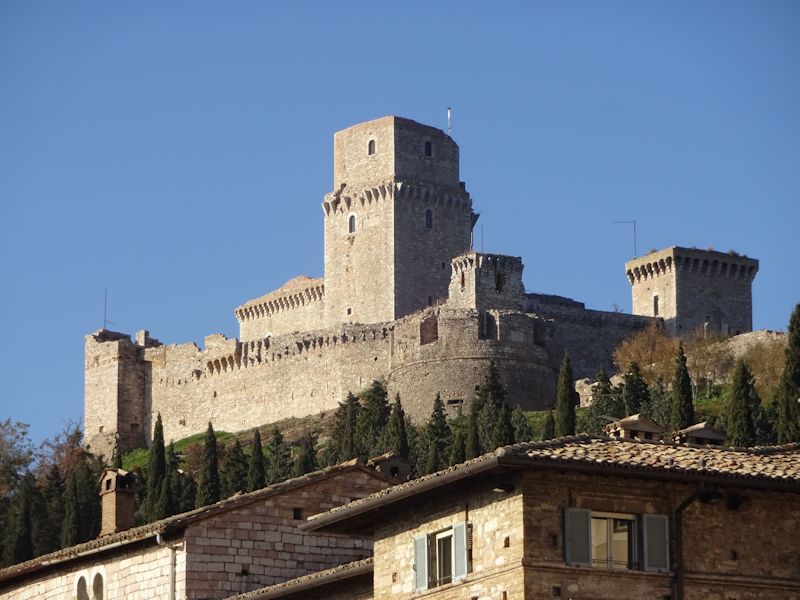
The Rocca, erected in the 14th century by the Cardinal Gil Alvarez Carillo de Albornoz (1310-1367), Archbishop of Toledo in Castile and successful warrior and general at a young age, who was chosen in 1353 to lead the Avignon pope's military campaigns to reclaim Italian cities for the Papal States, with the title of Grand Penitentiary and the nickname of "Angel of Peace".
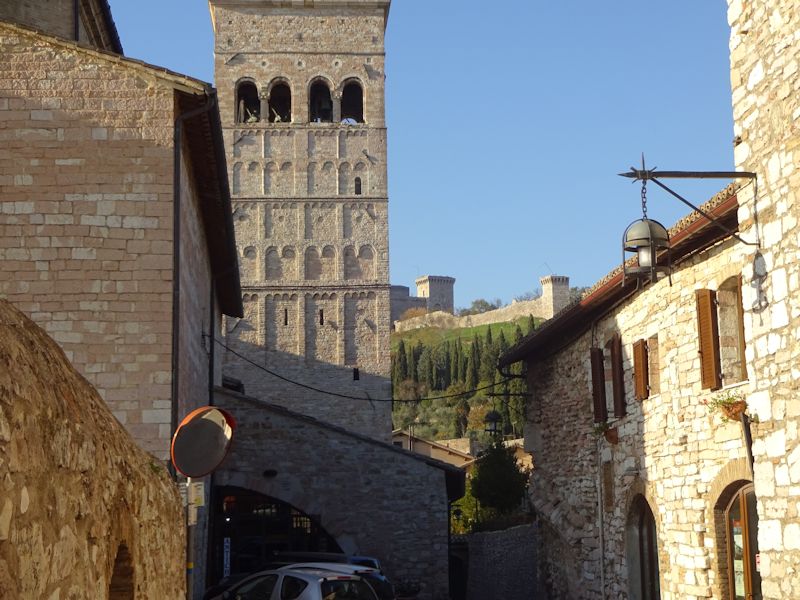
Up the hill behind the Duomo, the 11th century belltower (left over from the previous cathedral building), the top layers of which were completed in the 13th century. And the fortress keeping a close eye on things.
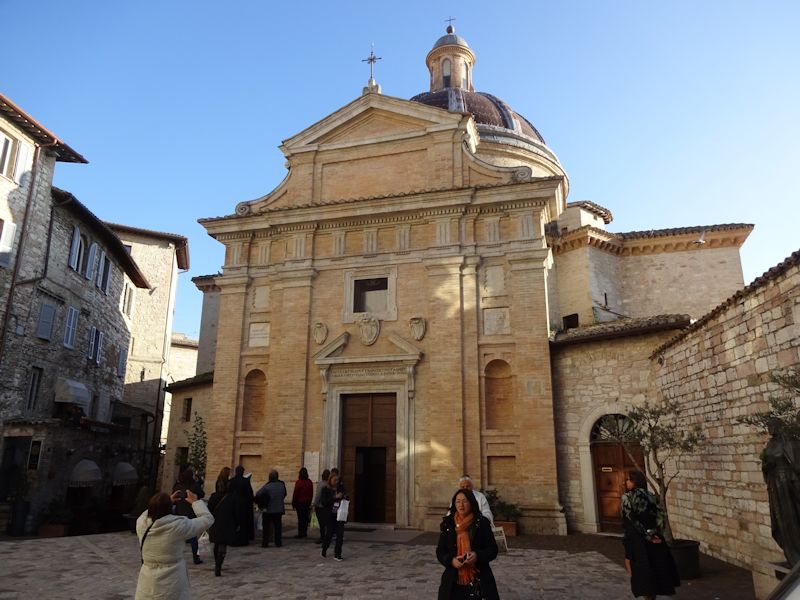
Back down the hill, this is the so-called Chiesa Nuova, built in 1615 supposedly on what was the birthplace of St Francis and family home of the Bernardones.
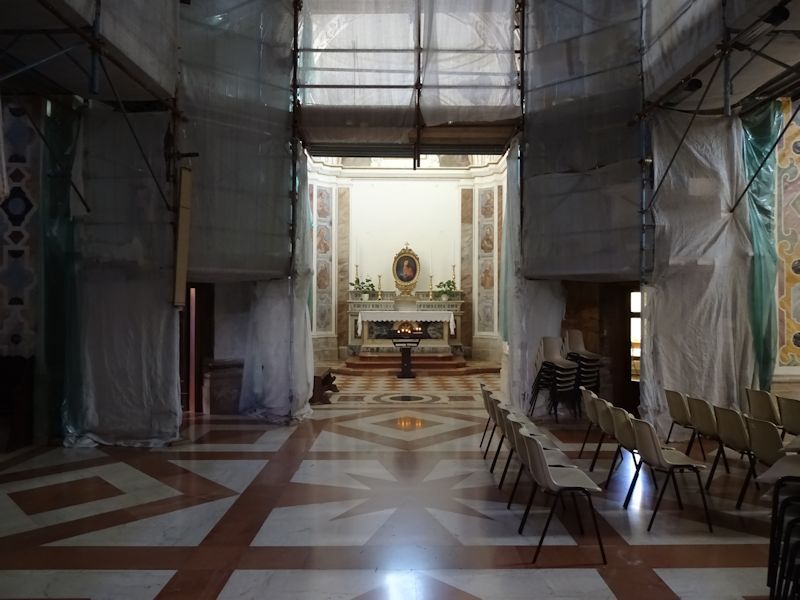
Newly a work in progress again, evidently
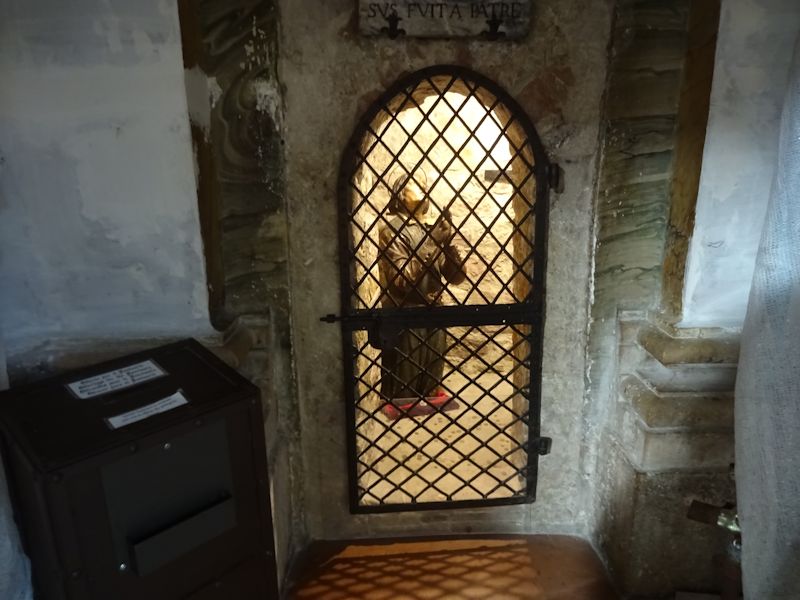
At the centre of the Greek cross plan, this is described as the original room where Francis' wealthy father imprisoned him to keep him from renouncing the high life and wandering the world in poverty. The St Francis now in there is just a statue.
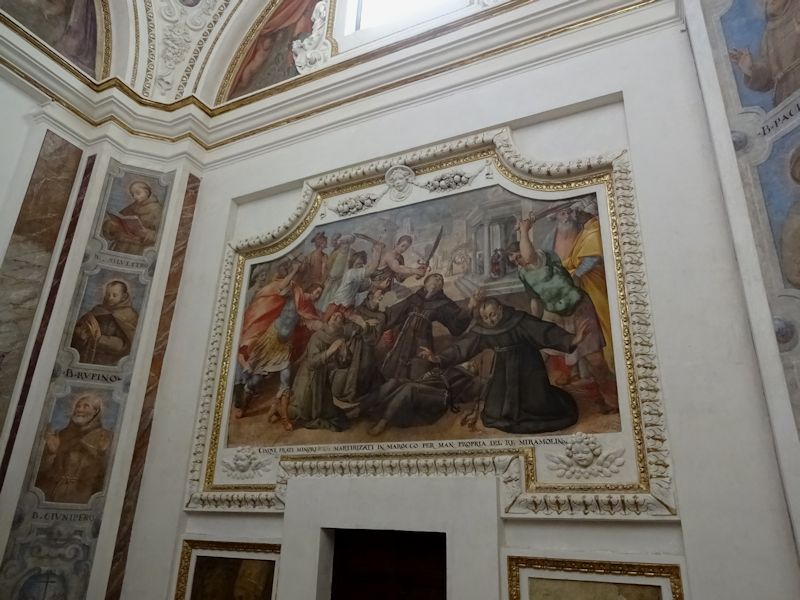
The followers of the Franciscan orders not only wandered the world in poverty, in later years they were famous for proselytizing to the heathen in Asia, Africa, and the Americas, whether the locals were pleased to see them or not, and at home they kept up their enthusiasm by celebrating the martyrdoms of their predecessors and friends.
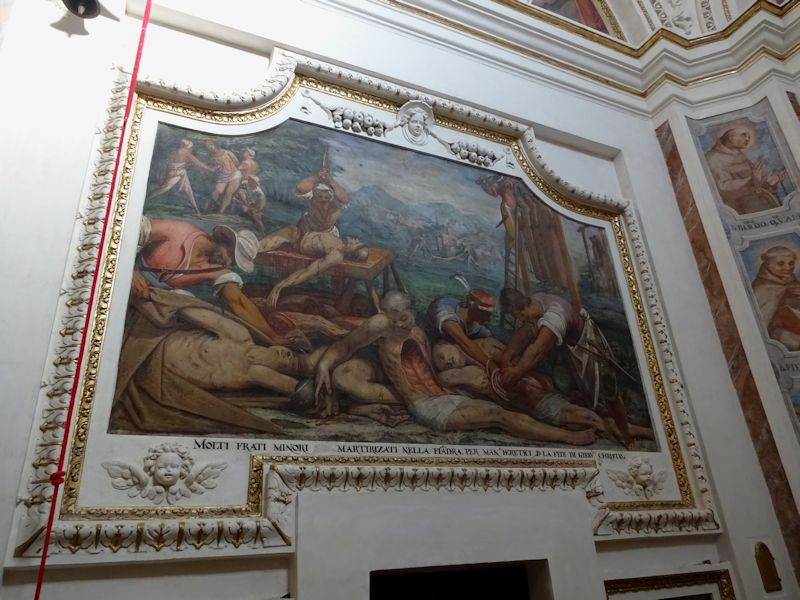
A sometimes gruesome preoccupation, one would think
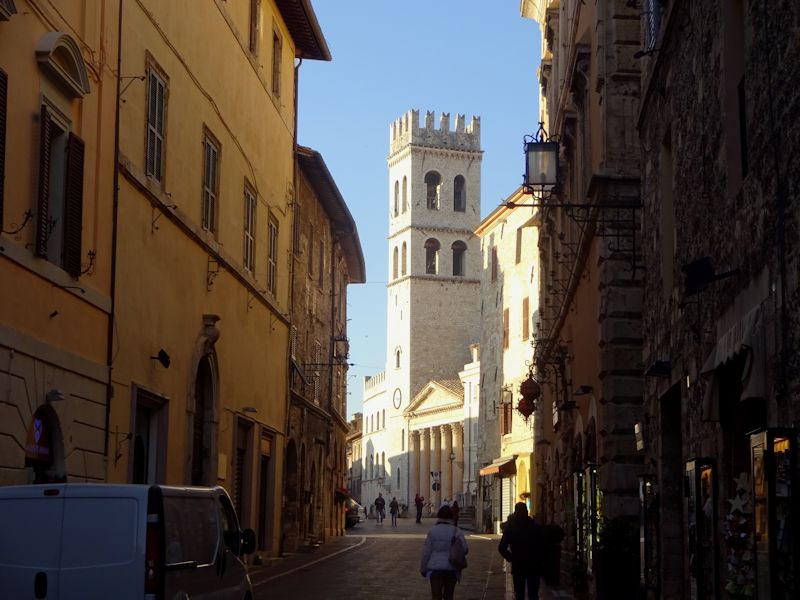
Leaving the Piazza del Comune
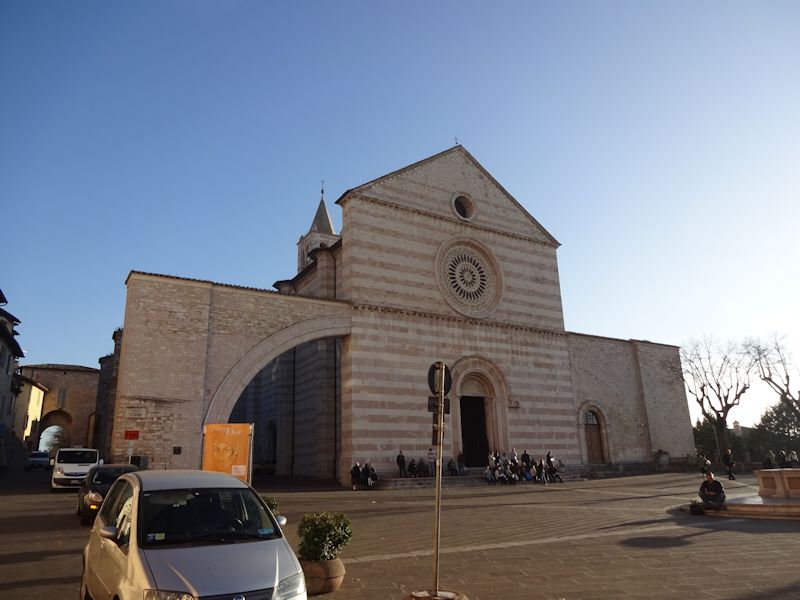
The Basilica di Santa Chiara was built in 1257-1265, dedicated to St Clare, Francis' follower and founder of the Order of Poor Sisters, later called the Poor Clares, and meant to look rather like the more imposing Basilica di San Francesco. The side buttresses had to be added in 1351 when the whole thing began to collapse.
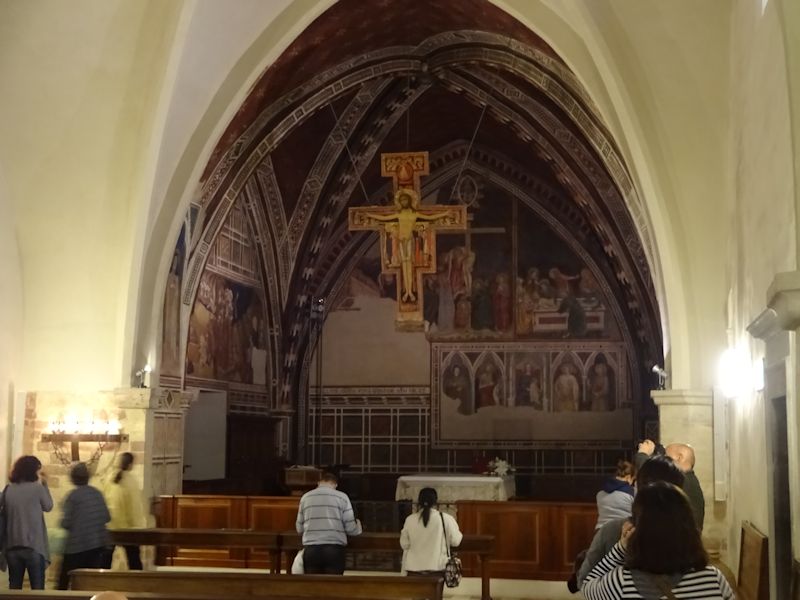
The interior is mostly bare -- according to the guidebooks, a 17th century Bishop had most of the frescoes destroyed lest the resident nuns be corrupted by tourists coming to admire them.
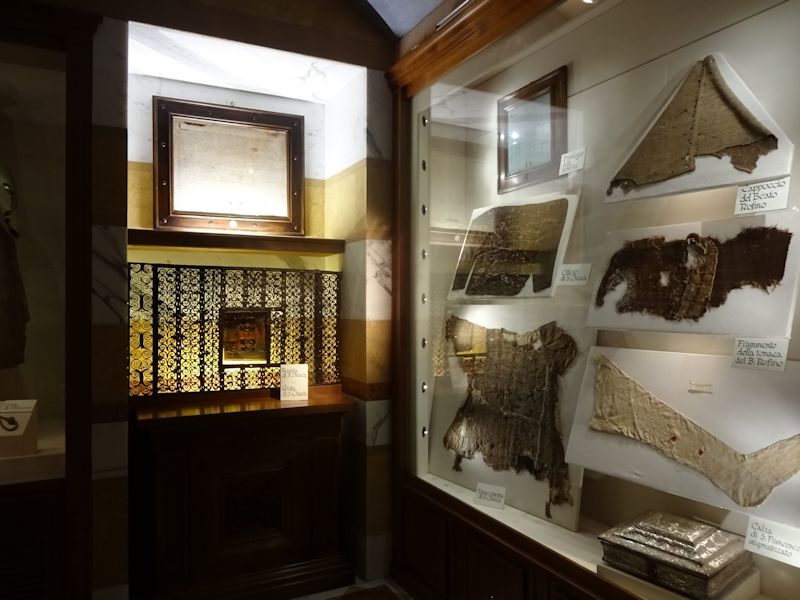
In the crypt, a collection of relics of Saints Francis and Clare
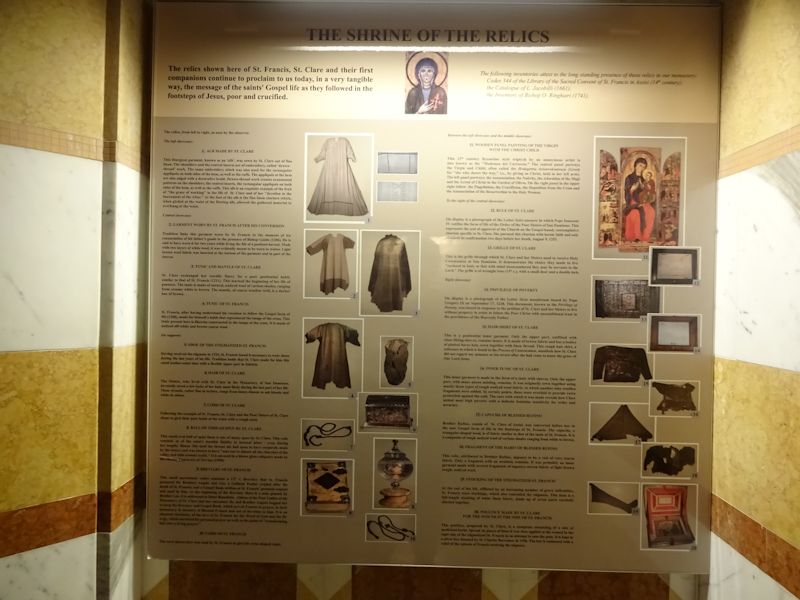
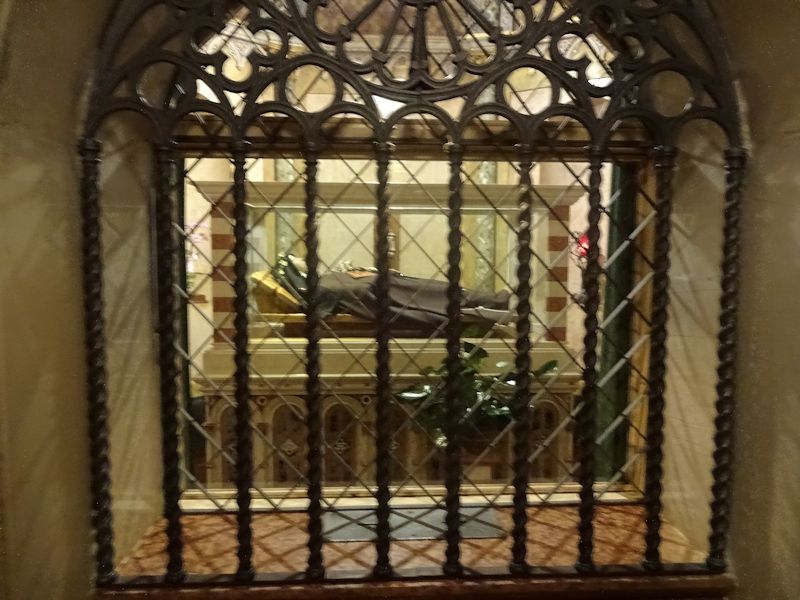
And that's either St Clare or her little sister Agnes, who's also present.
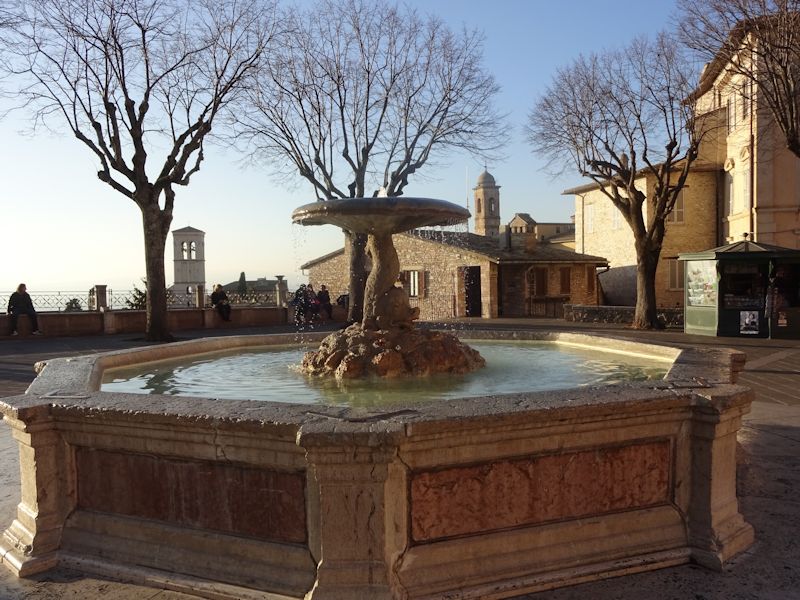
The fountain outside the Basilica di Santa Chiara, overlooking the Vale of Spoleto and the lower town
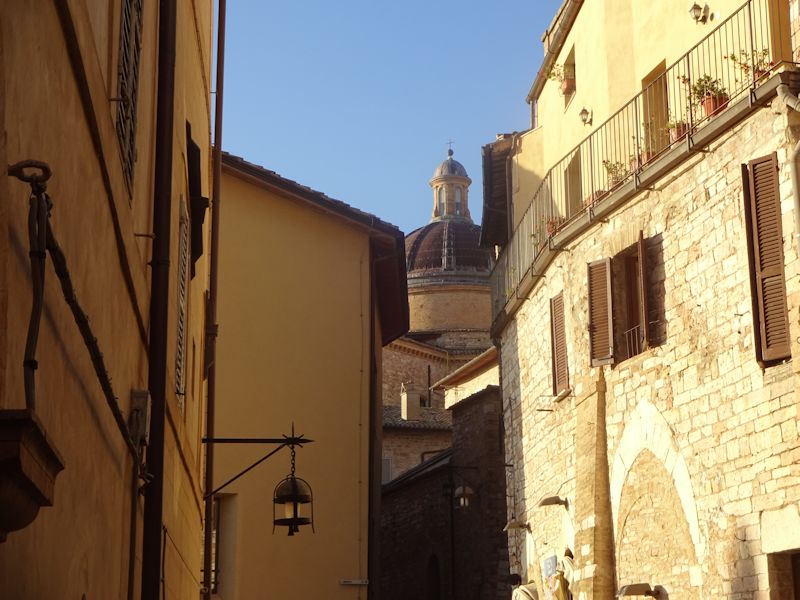
Down the Via Sant'Agnese and back to the carpark. Assisi is worth a visit, certainly, especially in the off season, but there does seem to be an impersonal atmosphere of "tourist destination" and sometimes tackiness to it, at least compared to other cities in the region, like Gubbio.














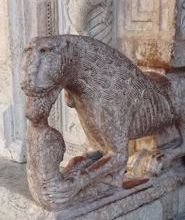 Dwight Peck's personal website
Dwight Peck's personal website








































































